183 7-DIGIT CODE LOCK
This code lock provides a high degree of security whilst being a very simple design. At the heart of the circuit is the Type 4022 octal counter. In the non-active state, C2 is charged via R5, so that the reset (R) input of the counter is kept logic high. This causes output Q0 to be actuated, while all other out puts are logic low. When S1 is pressed, T1 is switched on via debouncing network R2-C1 and IC, receives a clock pulse. Also, C2 is discharged via R4-D1, ending the reset state of the counter and enabling it to advance. The time required for R5 to recharge C2, i.e., to reset the counter, is the maxi mum time that can lapse before the next key is pressed. The above cycle is therefore repeated only when S7 at the Q1 output is pressed in time. When all keys have been pressed in time and in the correct order, Q7 goes high for about 4 seconds to enable driving the unlock circuitry, e.g. a relay driver for an automatic door opener. The code for the lock shown in the circuit diagram is 1704570: this is but an example, however, and the combination code is readily altered by swapping connections between the counter outputs and the switches. When the 7-digit code is considered too simple to crack, the 4022 can be replaced by a 4017, which makes it possible to add two keys. This means that the number of combinations is 10^9 instead of 10^7.
The quiescent current consumption of the code lock is negligible at 0.5 µA, so that battery operation is feasible. The circuit works well from any supply between 6 and 15 V. The accompanying photograph shows that the code lock can be built as a very compact unit thanks to the use of a printed circuit board that holds the 10 keys also.
Parts list
Resistors [± 5%]:
ITh
R3= 10K
R2= 220K
R4 = 100R
R5 = 1 MO
R6 . . . R12 incl. = 4K7
Capacitors:
C1;C3 = 100n
C2=4µ7; 16 V; axial
Semiconductors:
=1N4148
IC1 =4022
T1 = BS170
Miscellaneous:
S0 ... S9
Digitast momentary action button (SE or S version, ITT Schadow).
PCB Type 87436
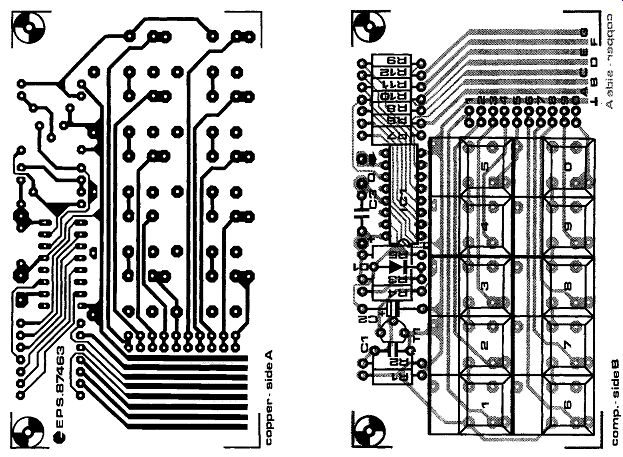
--------
184 ABSORPTION-TYPE METAL DETECTOR
The action of the detector, which indicates the presence of ferrous as well as non-ferrous metals, depends on the absorption of magnetic energy. An inductor, which forms part of a tuned oscillator circuit, radiates a magnetic field. When a metal object is introduced into this field, enough magnetic energy is absorbed to cause the oscillator to stop working,
The Colpitt's oscillator in figure 1 operates at a frequency of around 70 kHz. Inductor L1 also serves as the sensor. Because of the high value of the emitter resistor, R1, the oscillator only just operates.
This is desirable, otherwise any losses in the tuned circuit would easily be replenished by the transistor.
The oscillator output is rectified by D1 and D2, and the resulting direct voltage is applied to the inverting input of Schmitt trigger IC). If that voltage drops below the level at pin 3 (preset by P1), the output becomes logic high, and the relay is energized.
The detector is best constructed on the printed circuit board shown in figure 2 (this is, unfortunately, not available ready made). Inductor L1 is not in tended to be fitted on the board. This is a standard non-screened choke of 100 mH.
If the oscillator does not readily start at any setting of P1, the value of R, must be reduced. If, on the other hand, the oscillator does not stop working when a metal object is held near L,, the value of R1 must be increased. The stated value of R1 has been found right when L1 is a Toko type.
Starting with the wiper of P1 to earth, adjust the preset so that the relay just does not operate. If a lower sensitivity is required, advance the wiper slightly further.
Current consumption is determined primarily by whether the relay is energized or not; in any case it is not greater than 50 mA.
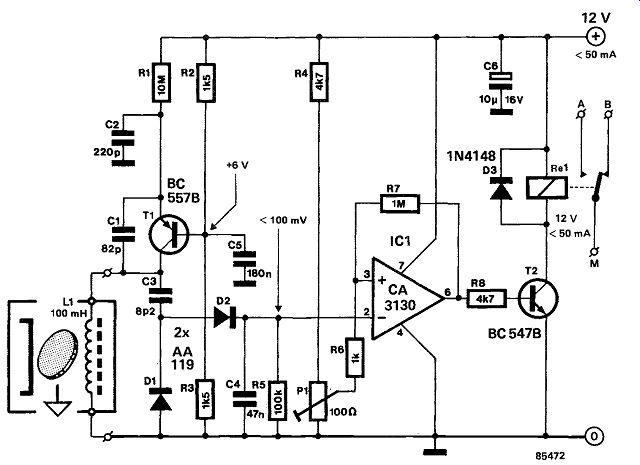
-------------
185 ALTERNATING FLASHER
The proposed circuit is intended for use by modelers at railway crossings, work in progress, advertising boards, and many others. It can be built quite quickly from but a handful of components.
In the accompanying diagram, A1 determines the flashing frequency, which may be altered by changing the values of R2 and, particularly, R3. The latter may be replaced by a suitable preset if the frequency needs to be varied often.
Inverters A2 and A3 function as fixed delay elements, while A4 inverts the drive to D2. The alternately flashing LEDs may, of course, be of any color suited to the application.
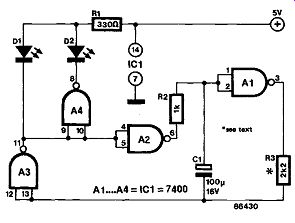
----------
186 AUTOMATIC SLIDING DOOR
Nobody pays much attention to automatically opening and closing sliding doors nowadays. In view of the complex mechanics involved, not too many people have so far attempted to fit an automatic sliding door in their living room. If you are happy with a relatively slow movement, such a door can, however, easily be realized with the aid of a DC motor and a small electronic control unit.
A suitable length of stranded nylon wire is attached to the left- and right-hand sides of the door and strung across four nylon roller guides as shown. The wire is attached to the spindle of a DC motor, the rotational direction of which depends on its polarity. Such motors are available in variety in many model building shops or from electrical suppliers, and should be suitable for operation from 6 . . .18 V.
It will be sufficient to loop the nylon wire a couple of times round the motor spindle. Correct tension is obtained by incorporating a tensile spring in the wire.
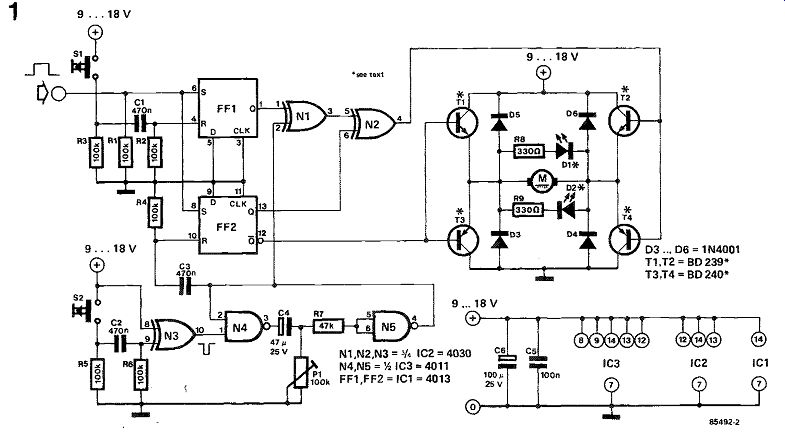
------
A small push button switch is fitted in the left- and right-hand door frames so that when the door is fully open or closed, a switch contact is closed.
You also need a light barrier or similar device that transmits a positive pulse of suitable length on the approach of a person. Such devices have been published in Elektor Electronics before, and there is also one elsewhere in this book.
The diagram in figure 1 contains a bridge circuit, consisting of transistors T, . . . T4 which, depending on the logic level at the bases of T1-T3 or T2-T4, determines whether the motor is at standstill, rotates clockwise, or turns anti-clockwise. When the circuit is being tested, the motor may be replaced by D1 and D2 (with limiting resistors R8 and R9 respectively).
The choice of transistors depends on the current drawn by the motor, which should not exceed 500 mA. T1-T3 and T2-T4 form complementary pairs, for instance, BD239-BD240, A short pulse at pin 6 of bistable FF, sets the door in motion: the first time, it may be necessary to re verse the connections to the motor! When the door is fully open, it touches switch S2. It does not matter whether it is just a touch or whether the door keeps the switch depressed: the motor stands still for a short time, which is adjustable with Pi, and then rotates in the opposite direction so that the door closes. If, while the door is closing, the light barrier is actuated, the motor changes direction again, and the operation repeats itself. When the door is closed, switch S1 provides a pulse which causes the motor to be switched off until the next time the light barrier is actuated.
187 BURGLAR DETERRENT
Most burglar deterrent systems are based on the same principle: once the presence of an unwanted or suspicious individual has been detected (by electronic or other means), some action ensues which makes it clear to passers-by or neighbors that something is amiss. It is often overlooked that the unwanted visitor first had to ascertain that there is nobody at home. The majority of burglars who operate by daylight just ring the bell. Once they have repeatedly rung without anyone answering the door, they go about their nefarious ways. Once in side, they may well set off a conventional alarm, but by then it is already too late. The circuit proposed here was designed to prevent the intruder getting that far. When the bell is rung, a number of monostables is actuated, which, after a suitable delay, switches on a cassette player that generates an awesome sound. This can vary from the barking of a large dog to the roar of a lion, depending on the premises. Sometimes a simple "sorry, no canvassers" may be adequate.
The circuit consists basically of two monostables.
The delay between the ringing of the bell and the cassette player being switched on is preset with P1 between 0.22 and 2.4 seconds. The time the cassette player operates is set with P2 between 47 s and 8 m 37 s. The cassette player is switched on via the relay contacts.
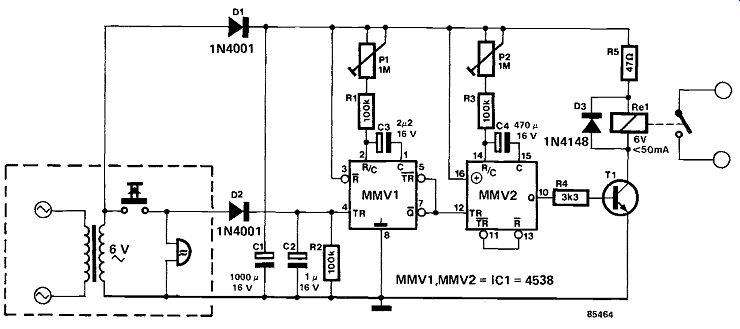
---------
The circuit is powered by_ the bell transformer. In the circuit it is assumed that this is a 6 V type, and the relay is, therefore, also a 6 V type (which here draws a current of 50 mA).
188 CALL COUNTER
A telephone has the unfortunate disadvantage that you have to be near it to be able to make use of its communication possibilities. If you have a tele phone answering unit, you know at least who has called and how many callers there were. If you can not, or do not want to, hire or buy such a unit, the present low-budget one may be of interest. Low-budget involves the limitation, however, that the in coming calls are merely counted: who has called, or what the message was, can only be guessed.
Moreover, to avoid problems with British Telecom (or whoever your PTT authority is), the unit is acoustically coupled to the telephone. Such a design must, of course, have excellent pulse suppression, since extraneous sounds must not be interpreted as an incoming call. Finally, the counter's current consumption should be (very) low to enable its operation from a battery.
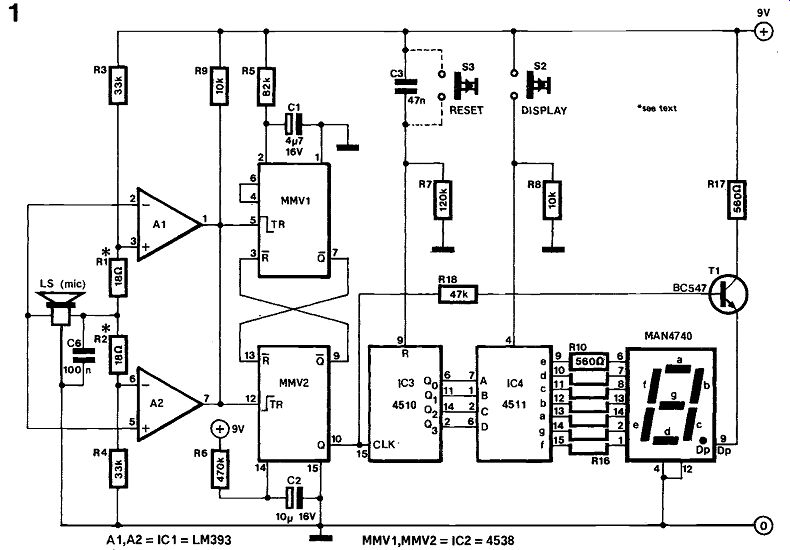
-----------
A small, inexpensive loudspeaker is used as the detector, the output of which is applied to window comparator A1-A2. In the absence of a signal from the detector, the output at interconnected pins 1 and 7 is logic high. When the loudspeaker picks up a sound from the telephone, the output consists of negative-going pulses. Monostable MMV1 is triggered by the leading edge of the first pulse, and sup-presses the pulse. Only after a time lapse of 0.4 s does MMVI enable a second monostable, MMV2.
If the sound is still being detected by the loud speaker, MMV2 is then also triggered. This arrangement ensures that noise pulses of less than 0.4 s duration are effectively suppressed. Since MMV2 is retriggerable, and its mono time is about 5 seconds, the intermittent ringing of the telephone is converted into a single pulse.
The decimal point of the display is switched on via R is and T1 indicating that the circuit is in a triggered state.
The remainder of the circuit is straightforward: a decimal counter, IC3, with switch-on reset R7 and C3, and a BCD 7-segment decoder, IC4. In the quiescent state, the display is not energized in order to keep the current consumption low. Pressing S2 will indicate how many telephone calls there were.
The circuit is reset by briefly switching it off, and then on again, but could be arranged by a simple switch across C3. Current consumption in the quiescent state amounts to about 0.6 mA, so that a reasonably long life may be expected from the PP3 battery.
If the input sensitivity is poor, it may be improved by lowering the value of RI and R2 to 10 ohm. If this is still not sufficient, a simple input amplifier as shown in Fig. 2 should be added. The LM393 is then replaced by an LM324, which has four suitable opamps. One of these is then used as input amplifier, and two of the remaining three as the window comparator. Diodes D1 and D2 are necessary in this case, because the outputs of the LM324, in contrast to those of the LM393, are not open-collector. The value of R21 is established by trial and error to find optimum input sensitivity.
Adding the input amplifier has the small disadvantage of increasing the current consumption to around 1 mA.
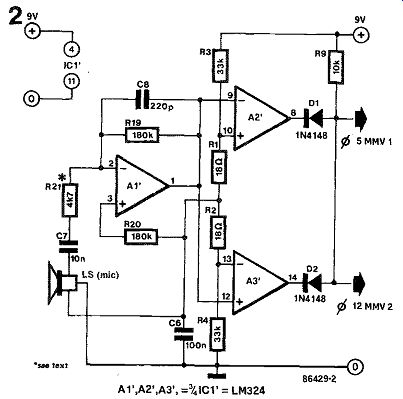
----
189 CENTRAL HEATING CONTROL
This circuit is used for optimum regulation of the flow of hot water in a central heating system. It measures the water temperature, and arranges for a particular valve or pump in the system to be switched on to achieve a user-defined temperature distribution in the home. Residual heat in the central heating system can thus be used to lower the cost of fuel. Fig. 1 shows that water in temperature range I can be used for the central heating and the storage vessel, while that in range II is also suitable for directing to the boiler. In most cases, it is not recommended to re-use water with a temperature below 30 °C. The circuit arranges for an alarm to be activated when the water temperature falls below 5 °C, or exceeds 95 °C.

------
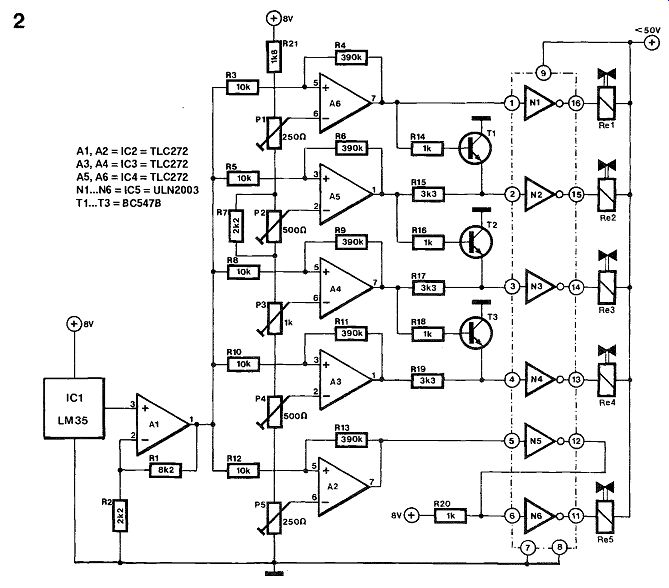

-------
The circuit diagram of the central heating control appears in Fig. 2. Relays Re, and Res are activated upon measuring the maximum and minimum permissible temperature, respectively. The temperature sensor is a Type LM35, which has a scale factor of +10 mV/°C. Its output voltage is amplified in A1 and fed to the non-inverting inputs of comparators A2-A6. The presets at the inverting input of each of these is used to set the toggle voltage, i.e., the temperature at which the relevant relay is switched on or off. The relay drivers are open-collector power buffers with built-in freewheeling diodes to afford protection against inductive surges. The use of the Type ULN2003 makes it possible to use relays with a coil voltage of up to 50 V without the need for additional interfacing.
Each temperature setting has a hysteresis of about 2 °C. Transistors T1-T3 serve to disable the previously energized pump or valve upon detecting a water temperature that falls within another, predefined, range. In this manner, only one relay is activated at a time.
It stand to reason that the temperature sensor, IC,, must be mounted such that it is in thermal contact with the water in the heating system. Make sure that the device is well-insulated, and that it does not cause leakage.
190 CH BOILER CONTROL
If you still alter your central heating system's boiler thermostat according to the season (many people nowadays leave it at the same- fairly high- set ting throughout the year), this may cause the boiler to be switched on and off too frequently when the weather is un-seasonly cold (see figure la). This problem may be resolved by the present circuit which prevents the boiler being switched on for some time, td, after the switch-off temperature, T2, has been reached. After td has lapsed, the boiler temperature, T, should have dropped well below the switch-on temperature, T1 (see figure 1b).
The circuit in figure 2 is an extension of the central heating monitor (Elektor Electronics, July/August 1984, p. 7-30) and formed part of the electronic gas meter (Elektor Electronics, November 1984, p. 11 59). The make contacts of a relay are inserted into the 24 V boiler circuit. The state of bistable N2-N3 determines whether transistor T1 is on or off, i.e., whether the 24 V circuit is open or closed. As soon as the bistable is set, T1 conducts and delay time td commences. At the same time, the reset of counter IC2 is cancelled. After some time, IC2 has reached maximum count: the consequent change of logic level at the output selected by S1 causes the reset of the bistable via N4. This is the end of td.
The set input of the bistable is connected to the collector of T3 in the central heating monitor via Ni and R3-C2 and R2-G. That transistor drives the LED that indicates the interrupted heat request of the boiler thermostat.
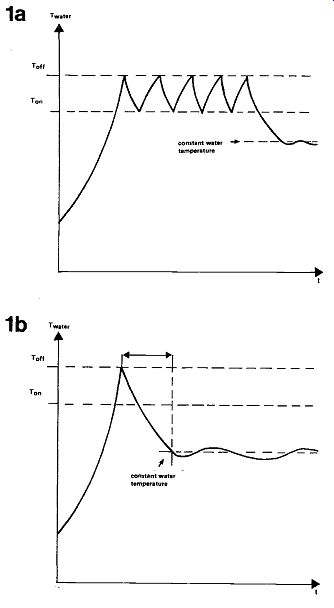
------------
Delay time to can be set within wide limits with P1 and S1. A period of 10 minutes is probably a good starting point. It is then impossible for the boiler to be switched on and off more than six times per hour. Based on the number of times the relevant LEDs in the central heating monitor light, you can alter the delay time with P1 and Si. Briefly connect the junction of R3-C2 to earth: this causes the bistable to be set; D3 goes out and the delay period starts. Adjust P1 so that D3 lights again after 5, 10, or 20 minutes. It is also possible to use periods of 4, 8, or 16, or 6, 12, or 24 minutes.
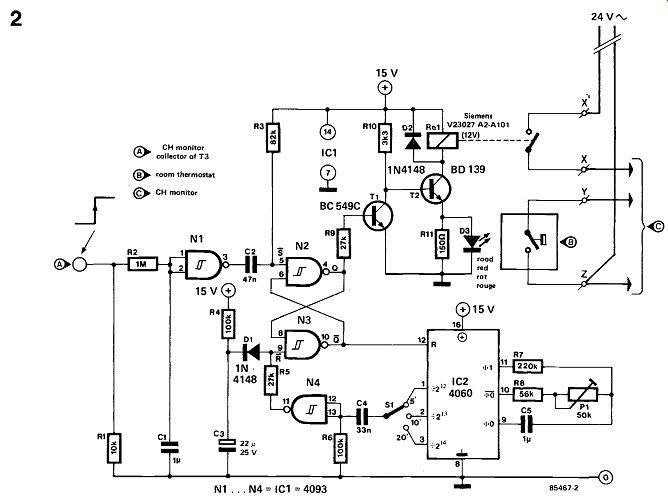
----------
191 COLOR WHEEL
Colored light effects enjoy a high popularity as ornaments, eye-characters, etc., and the present circuit proves how an apparently rotating color effect may be obtained with a mere handful of commonly available components.
The color wheel is composed of twelve bicolor LEDs, arranged in a circular form. First, a set of four red LEDs lights, followed by a green set, and, finally, amber. The colors are arranged to move in a clockwise direction, and at a speed that gives viewers the illusion that the motion is smooth and continuous.
The bicolor LEDs consist of anti-parallel connected green and red diodes in a single transparent case.
When both light simultaneously, their composite color, i.e. amber, is emitted.
Which group of LEDs lights depends on the duty factor of the drive signal from gates N5, N6 and N7.
Gate N1 is a clock oscillator whose frequency is controlled by Pi IC1 has been connected to function. as decade ring counter, which sequentially enables oscillators N2, N3 and N4 by a logic high level at counter outputs Q0, Q1 and Q2 respectively.
If, for instance, N2 is enabled, it oscillates at about 500 Hz with an output duty factor of 50%, causing both the green and red LEDs contained in D1 . . D4 to light. At the same time, D5 .. . D8 and D9 . . . D12 light as red and green, respectively, since the associated driver gates N6 and N7 provide a steady high and low level, again, respectively.

----
192 CURRENT MONITOR AND ALARM
These circuits are intended for remote monitoring of the current consumption on the domestic mains line.
The circuit in Fig. 1 lights the signal lamp upon detecting a mains current consumption of more than 5 mA, and handles currents of several amperes with appropriate diodes fitted in the D1 and D2 positions. Transistor T1 is switched on when the drop across D1-D2 exceeds a certain level. Diodes from the well-known 1N400x series can be used for currents of up to 1A, while 1N540x types are rated for up to 3 A. Fuse F1 should, of course, be dimensioned to suit the particular application.
A number of possible transistor types have been stated for use in the T1 position. Should you consider using a type not listed, be sure that it can cope with surges up to 700 V. As long as T1 does not con duct, the gate of the triac is at mains potential via C1, protective resistor R2 and diode D3, which keeps C1 charged. When T, conducts, alternating current can flow through the capacitor, and the triac is triggered, so that La1 lights.
The circuit in Fig. 2 is a current triggered alarm.
Rectifier bridge D4-D7 can only provide the coil voltage for Re, when the current through D1-D2 exceeds a certain level, because then series capacitor C, passes the alternating mains current. Capacitor C1 may need to be dimensioned otherwise than shown to suit the sensitivity of the relay coil. This is readily effected by connecting capacitors in parallel until the coil voltage is high enough for the relay to operate reliably.
Finally, an important point:
Many points in these circuits are at mains potential and therefore extremely dangerous to touch.
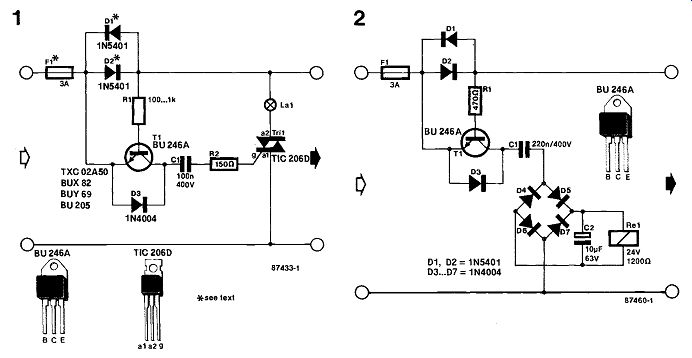
--------
193 DECEPTIVE LOCK
This circuit offers a means to fool all but the cleverest burglar, but, although it is a clever design, it has been kept simple, as a glance at the diagram will show. On the surface it looks like a simple operating panel with ten push buttons. However, anyone trying to open it illegally is in for a surprise! It is not just a matter of keying in the correct code, it is also necessary to keep one of the keys depressed for about 10 to 15 seconds.
The circuit is based on a single Type CD4093, which contains four NAND gates with Schmitt trigger inputs. Gates N1 and N2 form a bistable that contains the status of the lock.
Assuming that the circuit has been off for some time, switching it on causes network R1-C2 to set the bistable to the "lock" position, that is, the out put of N2 is logic low. Capacitor C3 is discharged, and the only way the circuit can toggle is by recharging this capacitor. This is done by pressing key Sx long enough for the trigger threshold of N, to be reached. When that happens, the bistable is set to the "open" position, that is, the output of N2 is logic high.
Capacitor C3 remains charged via R4-D2, even after Sx has been released. In other words, the bistable remains in the "open" position. The lock is closed again when one of the other keys is pressed, or, if required, by means of a special lock key. This causes C3 to discharge rapidly via D1-R3, which returns the circuit to the "lock" condition.
When the lock is "open", relay Re will also be open in the present circuit. It is, however, possible to have the relay energized in this condition by connecting the remaining free gate in the 4093 in series with R5 as an inverter.
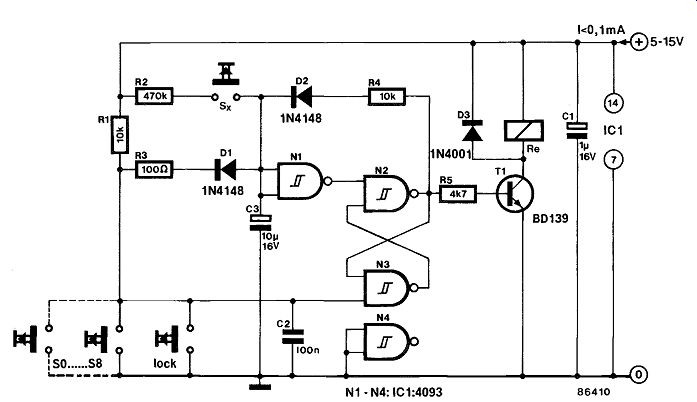
------------
194 DESICCATOR
Many of the smaller working areas available to hobbyists suffer from humidity, which in no time causes a number of tools to be covered in a thin layer of rust. Humidity does not do most test equipment or books and the like any good either. The only solution to this is to try to keep the area drier by in creasing the temperature.
A couple of 100 W light bulbs or a 100-200 W heating element work wonders in this respect, were it not for the increases in the electricity bill. And that is where the present circuit can help.
With reference to the diagram, the two HEF4001Bs, in conjunction with humidity sensor H, generate a voltage across R5 that is directly proportional to the degree of humidity. The function of opamp A1 is merely to present a high impedance to UR5. The voltage is then applied to the inverting input of comparator A2, which has an hysteresis of about 15 per cent. The reference voltage at the non-inverting input of A2 can be set between 0.6 V and 3.0 V with P1, which corresponds to a humidity be tween 20 percent and 100 percent. As soon as the ambient humidity exceeds the value set by the comparator toggles, the triac conducts and switches on the heating element. Current consumption of the circuit is a modest 13 mA.
If light bulbs are used, they should be shielded with a metal hood to prevent the likelihood of a fire.
Calibration is carried out with the aid of a solution of cooking salt in some water; placed in a reasonably small, closed space, this will soon raise the humidity to 75 per cent. Adjust C1 to obtain a potential difference across R5 of 2.25 V. Next, ad just P1 so that the triac just does not conduct. In practice, the circuit will then come on at a humidity of about 80 per cent.
For further details of this circuit, see also the April 1981 (p.19) and July & August 1981 (p.72) issues of Elektor Electronics.

------------
195 ELECTRONIC BELL-PULL
The simplest circuit in this issue of Elektor Electronics consists of a single transistor and resistor, which, when put together as shown, constitute the electronic equivalent of an old fashioned, stylish bell-pull used in conjunction with a chime or bell circuit of any relative complexity offering whirling melodies, buzzing or ringing sounds, or chime imitations to prompt the house-owner to open the front door.
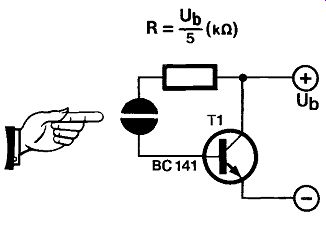
----------
The bell-pull is made from a TO39-style NPN transistor which is taped or isolated by means of a length of heat shrink sleeving, after the emitter and collector leads have been fitted with wires for the electrical connection to the bell circuit. A small, conductive plate is secured onto the isolated transistor head, and the base lead is joined to this plate over a series resistor which is dimensioned according to R = Ub/5 [k-Ohm]. The completed assembly may also be cast into epoxy resin to make a nice compact unit that can handle the treatment of even the roughest caller at the door!
196 ELECTRONIC DOG
To produce a faithful reproduction of the voice of man's best friend, we have borrowed several ideas from our music synthesizer. When push button switch S2 is pressed, the frequency of voltage-controlled oscillator (VCO) A1-A2 changes in about an eight of a second from almost 0 Hz to a pre-settable value of 100 . . .1000 Hz. That signal is passed through band-pass filter A5-A6, the center frequency of which corresponds with the highest VCO frequency. Voltage-controlled amplifier (VCA) T1 ensures that the single pulse generated by the VCO when S2 is open cannot be heard.
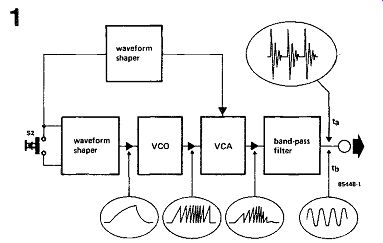
------------
Gates N1 and N2 form a monostable relaxation oscillator. When S2 is closed, a short pulse appears at the output of N2 that charges capacitor C2. Because of R3, the pulse shape will be as shown in figure 1.
This pulse controls the output frequency of the VCO as also shown in figure 1. Potentiometer P1 determines the highest frequency: its setting depends on whether you want the sound of a yapping poodle or the deep bark of an alsatian.
The function of C4 is similar to that of C2: it shapes the pulse applied to the VCA. This transistor behaves as an electronic potentiometer, i.e., it operates as a voltage-controlled resistor. Adjusting potentiometer P2 influences the manner in which the tone decays after the switch has been released.
Instantaneous dying of the tone would sound just as unreal as its lingering on. With a little care, and after some practice, it will be possible to create a variety of canine dialects.
The center frequency of band-pass filter A5-A6 is set with P3.
Correct setting of this is important, but here again, trial and error is probably the best way.
With the output connected to a power amplifier, the combination can be used as an alarm installation: even dyed-in-the-wool burglars think twice before they risk entering a house that is obviously guarded by a fierce dog!

-----------
197 FLASHING LIGHT WITH TWILIGHT SWITCH
The special feature of this flashing light is the optical switch, which automatically switches the light on when it gets dark, and switches it off again at dawn. This makes the light ideal as a warning light near obstructions. It may also be used for educational purposes to show the operation of transistors in conjunction with optoelectronics.

-------------
Assuming that it is light, the LDR (light dependent resistor) has a low value so that there is sufficient base current through T1 for the transistor to conduct. Its collector voltage is then small, so that T2, an n-p-n darlington, is off, and lamp L1 stays out.
When the ambient light reduces, the resistance of the LDR increases until the base current in T1 becomes insufficient and the transistor switches off.
Its collector voltage then rises, T2 conducts, and L1 lights. This process takes place quite quickly, because when the collector voltage of T2 suddenly becomes nearly 0 V, this potential is immediately applied to the base of T1 via capacitor C1, which really cuts off T1. The capacitor then charges via P1 and the LDR that is now being illuminated by the lighted lamp. Owing to the optical feedback, the value of the LDR diminishes, the voltage across R2 increases, and T1 conducts again. The darlington switches off, and the lamp goes out: a new cycle has started.
The flashing frequency is primarily dependent on the value of with 47 uF, it is rather low; reducing the capacitance increases the frequency.
The BC 517 darlington may be replaced by two BC 547B transistors or a VNIOKM MOSFET. The only thing that needs watching is the current through L1: the maximum permissible with two BC 547Bs is 100 mA; with a BC 517 it is 400 mA; and with a VNIOKM it is 500 mA. Current consumption of the circuit, with lamp L1 out, is about 6 mA at 6 V and around 10 mA at 10 V.
The light-dependent resistor may be one of the usually available types: LDR 03, 05, 07. To ensure that the optical feedback works, the LDR must be fitted near lamp L1. The onset of operation is set with Pt.
198 FOUR POSITION TOUCH DIMMER
----------

Any electric light may be adjusted with this dimmer to very low, low, medium and maximum, which in most cases will be sufficient. After all, it is all very well to be able to control an electric light over the whole range of its brightness, but how often is that facility really used? Moreover, in everyday use, position control has practical advantages: setting, for instance, takes a second or two.
The circuit is based on an LS7237 and some discrete components. The dimmer may also be used as an electronic on/off switch, in which case the mode select pin (7) must be connected to earth (pin 1). Such a switch does not produce sparks and consequent noise in nearby electronic equipment. Another possibility is leaving pin 2 open, whereby a three position dimmer ensues: low, medium, and maxi mum.
The LS7237 has all the necessary facilities to drive silicon-controlled rectifier (SCR) Tri1. Resistor R2 and capacitor C4 filter a 50 Hz signal from the mains that serves to synchronize the on-chip phase locked loop.
Network R1, C2, and D2 provide the supply for the LS7237, while filter L1/C1 prevents excessive noise from reaching the mains supply.
Different types of triac may be used, as long as these can provide the required current, and are suitable for operating voltages of not less than 400 V. For safety's sake, no deviations from the stated voltage ratings of the various components should be tolerated. The two 4M7 resistors provide ample safety for the user: under no circumstances should these be replaced by a single 10 M ohm resistor! The complete circuit is small enough to be accommodated in the pattress or plaster box of a light switch.
199 HOTEL SWITCH
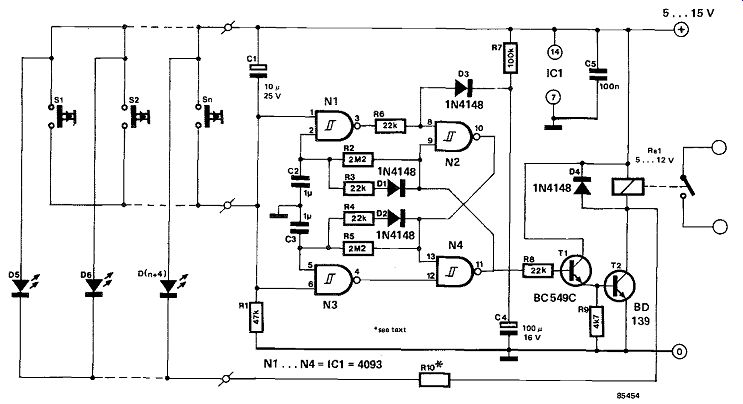
It is often required to switch an electric light or apparatus from various positions in a building. A typical example of this is the hotel switch, which makes it possible to control lights from a number of positions. With some electronics and electric wiring, the number of switching positions may be extended ad infinitum.
The actual switching is effected by a relay that is controlled by an R-S bistable, N2/N4, via transistors T1 and T2 The state of the bistable is of import to the position of logic switches Ni and N3. A trigger pulse at the junction of R-1 and CI is only applied to that input of the bistable which causes the bistable to toggle. In other words, a train of trigger pulses, 0;1;0;1;0 , with a minimum interval be tween pulses of a few seconds, results in a series of logic level changes which causes the relay to be actuated and de-energized alternately.
The trigger pulses arise when one of the push buttons, S1 . ..Sn, is pressed briefly. The push buttons are all connected in parallel, so that they can be interlinked by a two-wire system.
It would be possible to fit an LED at every switch position, but this would entail an additional wire.
Such LEDs would, of course, also be in parallel, so that it is advisable to use similar types.
The value of resistor R10 is calculated from R10 = ((U- 2)/IDn) ohm where U is the supply voltage in volts; ID is the current through each LED in A; and n is the number of LEDs.
200 INDUSTRIAL-CLOCK CONTROLLER
Nowadays, most clocks and watches are quartz con trolled and, therefore, accurate to within a few seconds a year. Older type electric clocks, particularly those used in large groups in warehouses, department stores, factories, railway stations, and so on, were centrally controlled and synchronized.
This synchronization was effected by pulses derived from the mains and sent to each clock via a separate cable network. Many people have such a clock as a curiosity, but have not the means of driving it. The circuit described here will help . .
With reference to the diagram, pulse shaper T, triggers monostable IC2 at the mains frequency of 50 Hz. Counter IC3 is reset automatically after every 3000 pulses by IC4 and T2. At the same time, bistable IC5 toggles and causes the bridge circuit composed of T2 . . . T8 to reverse the motor polarity every 60 seconds.
Depending on the type of clock you have, the transformer secondary voltage may have to be selected to supply about 0.7 times the normal operating voltage of the clock motor. Furthermore, the bridge circuit as shown should not be made to operate at voltages in excess of 30 V, while the maximum current is about 250 mA.
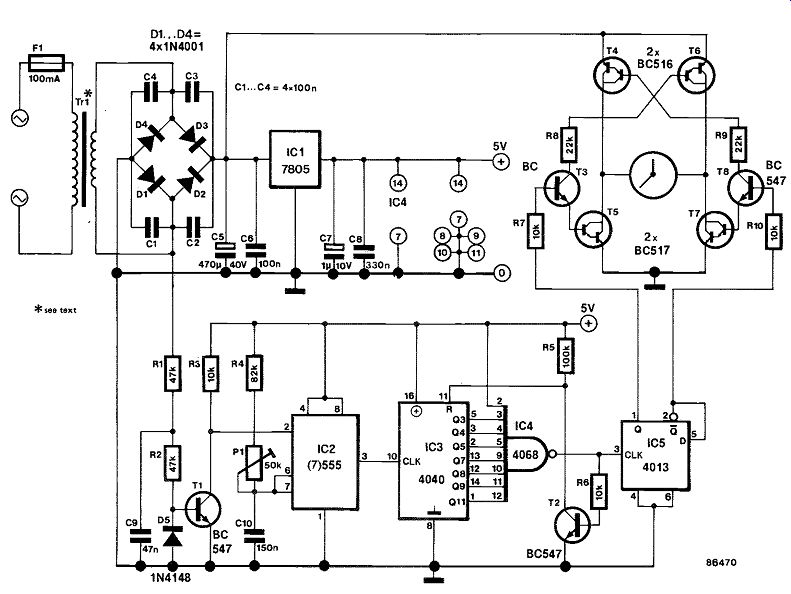
----------------
There is only one adjustment point in the circuit, namely P1, which should be set to achieve maxi mum suppression of mains borne noise; if this can not be checked, the preset may be turned to its center position. Should the clock be slow, P1 may be adjusted to give a slightly lower resistance, but care should be taken to avoid setting a monostable time longer than 20 ms, as in that case only half the number of 50 Hz periods can reach the counter.
201 INFRARED LIGHT BARRIER
Infra-red light barriers enjoy great popularity as timing devices at sports venues, as detectors in alarm installations, as optoelectronic switches in counting equipment, and many others, because of their low cost and immunity to electrical interference.
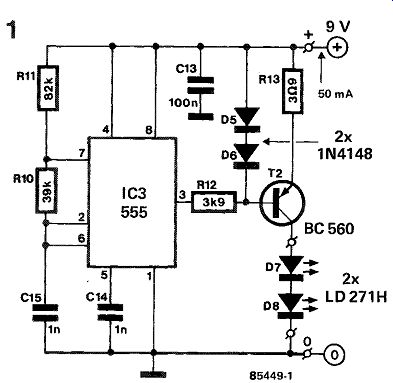
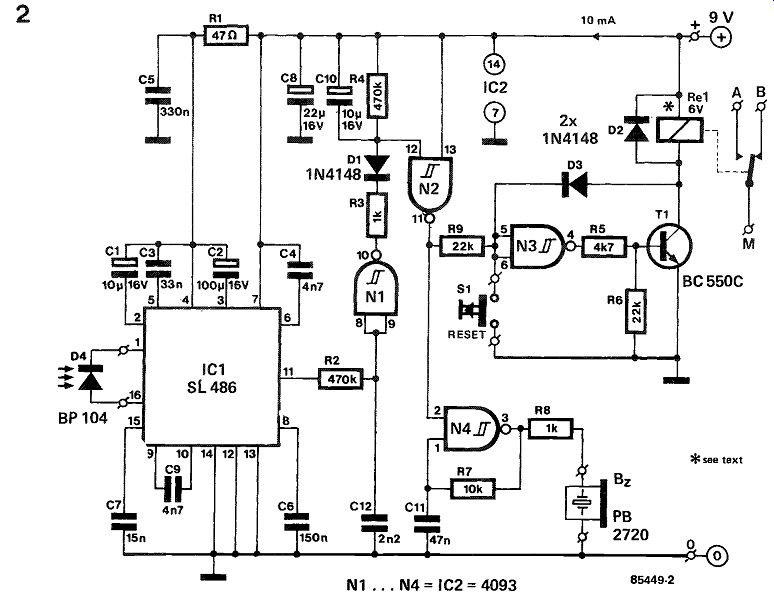
-----------
The present light barrier consists of a transmitter and a receiver.
---------
Parts list (receiver)
Resistors:
R1 = 47 ohm
R2, R3 = 470 k
R3,R8 = 1 k
R5 = 4k7
R6,Ra = 22 k
R7 = 10 k
Capacitors:
C1,C10 = 10 µ/16 V
C2 = 100 uF/16 V
C3 = 33 n
C4, Ca = 4n7
Ca = 330 n
Ca = 150 n
C7 = 15 n
Ca = 22 u/16 V
C11= 47n
C12 = 2n2
Semiconductors:
D,... D3 = 1N4148
D4 = BP104
T1 = BC550C
IC1 = SL486 (Plessey)
IC2 = 4093
Miscellaneous:
Re1 = PCB type relay, 6 V
Bz = piezoelectric buzzer (Toko type PB2720 or equivalent)
S1 = spring-loaded push-to-make switch
Parts list (transmitter)
Resistors:
R10 = 39 k
R11 = 82 k
R12 = 3k9
R10 = 3 omega 9
Capacitors:
C13 = 100 n
C14, C15 = 1n
Semiconductors:
D5, D6 = 1N4148
D7, D8 = LD271H
T1 = BC560 IG = 555
Miscellaneous:
Reflectors for D7 and D8 (optional)
PCB 85449
--------- The transmitter, shown in figure 1, consists of an astable multivibrator (AMV), lC3. The output of the AMV, pin 3, consists of a pulse stream with a duty factor of about 30 percent. The output is connected to a constant-current source, T2. This source provides infra-red transmit diodes D7 and D8 with a current of just over 20 mA, which pulsates in rhythm with the output signal of the AMV. The infrared light is, therefore, transmitted in rhythm with the pulse stream also.
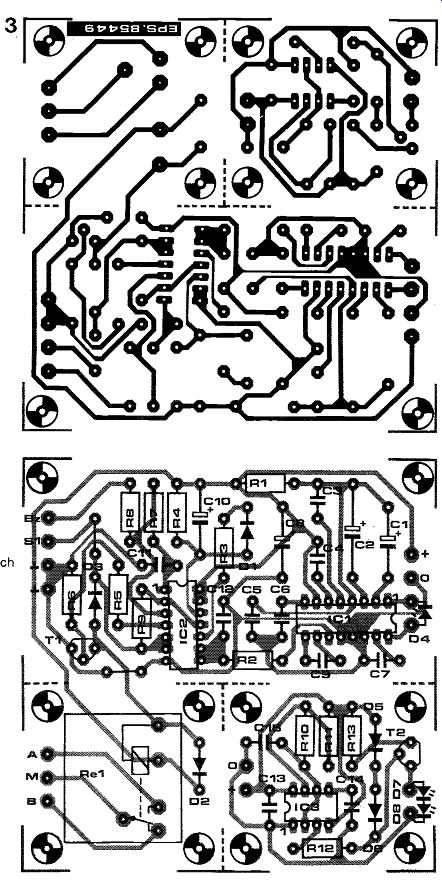
----------
The receiver, shown in figure 2, is based on an SL486 demodulator, IC). The output of the demodulator, pin 11, also consists of a 10 kHz pulse train with a duty factor of around 30 percent. This pulse stream is applied to integrator R2-C12. The logic level at the input of N, remains low as long as D4 receives the pulsating infra-red light. Because of this, monostable N2 is disabled, and oscillator N4, which drives a piezoelectric buzzer, is switched off.
Relay Re1 is, however, energized via N4 and transistor T1.
When the pulse stream between D7-D8 and D4 is broken, the logic level at pin 11 of IC, goes high, so that the output of N1 becomes logic 0, which triggers monostable N2 via D1. Oscillator N4 is then switched on and actuates the buzzer. At the same time, N3 ensures that T1 is switched off, so that the relay returns to its quiescent state.
When the monostable pulse decays, which with the stated values of R4 and C10 is after about 5 seconds, oscillator N4 stops and the alarm tone ceases. Diode D3 ensures that the relay remains in its rest state, however, by transferring the high voltage level of the collector of T1 to the input of N3 whose consequent low logic output continues to hold the transistor off.
The equipment switched by the relay contacts, therefore, does not only indicate when the light barrier has been interrupted, but also when the supply voltage has failed. The relay is re-energized when reset switch S1 is operated. If D3 and S1 are omitted, the relay is re-energized when the monostable pulse has decayed.
Current consumption of the transmitter is about 50 mA; that of the receiver around 10 mA.
The printed circuit board shown in figure 3 is in tended to be cut into three along the dashed lines, although it may not be necessary in some situations to cut the relay section from the receiver section. If the latter two are separated, they should on completion be interconnected by a suitable cable.
202 JUMBO DIMMER
The name jumbo dimmer points to its association with the Jumbo Display (see EE, July & August 1985), but it can, of course, also be used with other appliances such as lamps, pumps, ventilators: in short for all applications where a direct voltage is to be controlled by pulse duration modulation.
With reference to the diagram, A i is a rectangular-wave generator: a useful by-product of this stage is the (quasi) triangular voltage at its inverting input.
This signal is applied to the non-inverting input of comparator A2. The reference voltage for this stage is derived from preset P1. The output of the comparator is a rectangular voltage with a frequency of around 200 Hz and a pulse duration that is variable between zero and 100 percent. The onset point of the pulses is determined by the setting of P1.
The actual control function is provided by transistor T1, which switches the relatively large display cur rent of up to 5 A. The supply voltage must lie between 5 V and 30 V: note that the efficiency of the circuit is directly proportional to the supply voltage.
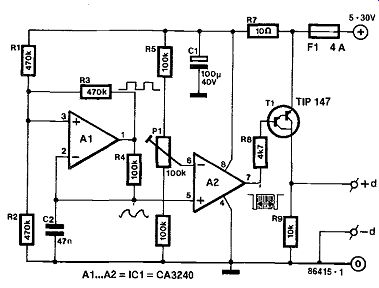
-----------
203 JUMBO DISPLAYS
Although this project will not be of interest to everybody, it has many possible applications. The name refers to the respectable dimensions of the seven-segment displays: 280 x 140 mm. These sizes immediately indicate that the displays are intended to make alphanumeric information legible at a distance. This is of import, for instance, for score boards, speed indicators, lap counters, digital church clocks, etc.
These displays have a number of advantages:
they are entirely solid state, which prevents segment failure since the life of LEDs is much longer than, for instance, that of incandescent lamps;
they do not need intricate reflector constructions;
if any one LED fails, they remain fully legible by virtue of the special segment construction;
they are easily arranged in a variety of colors--red, green, blue, yellow, orange;
they work from 24 V with relative high efficiency, which keeps heat dissipation low.
It may be said that the large number of LEDs required is a disadvantage, but, in our opinion, this is largely negated by the advantages.
Figure 1. Circuits for the control of (a) a seven-segment display; (b) a "1" display, and (c) a ":" display.

------------
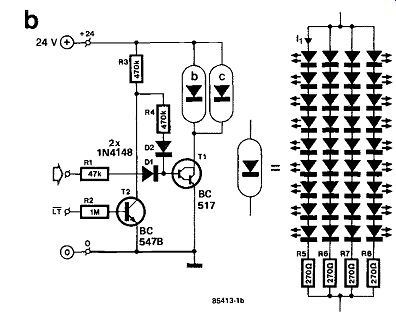

Figure 2. Correlation between the input and output signals of a 74LS248 decoder and a seven-segment display.
Figure 3. Printed circuit boards for the " :" display; the seven-segment display; and the "1" display.

----------
The seven-segment display, shown in figure la, is based on a type 74LS248 decoder, which has the same features as the well-known type 74LS471247, but has in addition internal pull-up resistors and inverted output signals, so that external transistors can be used to cope with the large currents drawn by the segments. The inputs and outputs to the decoder, the read-outs, and the additional functions are correlated in figure 2.
All input and output controls have been arranged external to the decoder, so that they can be used in the same way as with normal displays. Wire link R S serves to interconnect the earths of the + 5 V and + 24 V supplies.
At the output of the decoder there is a switching stage for each segment that switches the relevant segment on or off.
Each segment consists of four parallel groups of eight or nine LEDs in series with a current limiting resistor.



------
Parts list
Seven-segment display:
...R7 = 100 k 198...Fill (7X) = 270 ohm (with 9 LEDs)
= 330 ohm (with 8 red LEDs)
= 390 ohm (with 8 green LEDs)
= 74LS248 T1 .. . T7 = BC517
C1 = 100 n 232 LEDs, 5 mm, color as required "1" display:
= 47 k
R2 = 1 M
R3, R4 = 470 k
R5 . R8 (2X) = 270 ohm
D1, D2 = 1N4148
= BC517 BC547B 72 LEDs, 5 mm, color as required ":" display:
19-1, R2 = 270 ohm 18 LEDs, 5 mm, color as required
PCB 85413-1
PCB 85413-2
PCB 85413-3
The displays can be powered from a non-stabilized 20...24 V supply. The current drawn per segment varies from 50 mA to 100 mA.
Figures 1b and 1c give the diagrams for displays with a "1" and a ":" respectively. Both can be used for a 12-hour clock. The "1" display has provision for a lamp test (LT); open inputs are considered active, i.e., the display lights. This is in contrast to the seven-segment display which treats inputs that are not connected as logic high, that is, inactive.
As mentioned earlier, read-out boards consisting of several figures may be composed by mounting a number of displays side by side on a flat base. The whole may be protected by translucent red perspex: this also acts as a light filter, which improves the legibility considerably.
As you need a large number of LEDs, shop around for these because many dealers are prepared to allow a quantity discount. Uniformity of brightness of these diodes is not so important for this application, because at the distances for which these displays are intended, differences in brightness do not show up.

-------
204 LED DIRECTION INDICATOR
An LED indicator with a difference: three alternately lighting LEDs indicate a direction, for in stance, in a model railway, or to an emergency exit, or to a door on badly lit stairways, and so on.
When the supply voltage is switched on, the inputs of gates I14. . . N6 are logic 1, their outputs logic 0, and all LEDs light. One of the RC networks (R, + R2/C2; R3/C3) will reach the trigger threshold first. Let us assume it is R, + P,/C,. The output of N1 then goes low, the output of N4 goes high, and DI goes out. There is then no voltage for R2/C2, the output of N2 remains logic high, and N5 remains logic low: D2 then lights. Subsequently, the output of N3 goes low, the output of N6 becomes 1, and D3 goes out. The logic 0 of N3 is, after a delay in R, + P,/G, again at the input of N1. The out put of N1 goes high, that of N4 goes low, and D1 lights. This process repeats itself, so that first one, then two, and then one LED again lights. At every step, the light pattern shifts one place to give the impression of a running, flashing light. The running speed is set with Pt. It does not really matter whether you use inverting gates (4049) or non-inverting ones (4050) in the IC2 position, as long as you connect the unused gates to the positive or negative supply rail. The RC net works may also be modified to taste or if special effects are desired.
If you want to make the circuit even smaller, forget IC2 and use the three remaining inverters in IC, as LED drivers, provided you are using a type 40106.
The LED currents are then only 5 . . .10 mA, so you have to use high output LEDs (that are bright at low currents).
The current consumption of the circuit without LEDs and operating from 15 V is about 100 µA.
With LEDs, it depends very much on the LEDs and the supply voltage: with standard LEDs and at 15 V, each LED draws up to 30 mA.
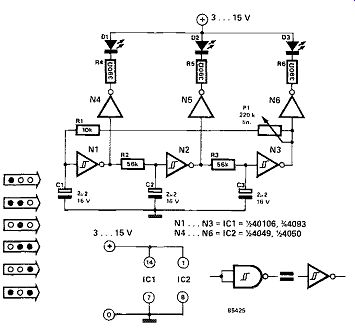
-----------
205 LIGHT-SENSITIVE SWITCH
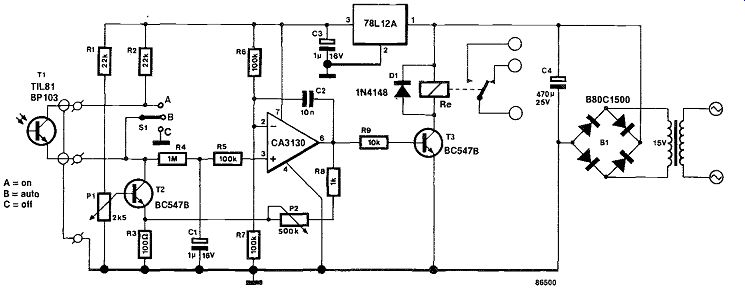
-----------
This switch is energized by light and can, therefore, be used, for instance, to switch on the aquarium lighting in the morning. Both the sensitivity and the hysteresis of the circuit can be preset; Re is energized in the presence of sufficient light.
The sensor is an n-p-n phototransistor Type TIL81 or BP103, which conducts when light falls upon it.
The consequent current is divided between T2 and R4-C1. Since T2 is connected as a current source, no current will, however, flow through Ra-C, as long as the current in T1 is smaller than that through T2 as determined by P1. When the current in T1 is large enough, some will flow through R4 and charge C1.
As soon as the resulting potential across C1 is greater than half the supply voltage, the CA3130 toggles. A current then flows through R8, P2, and R3, which will cause a small reduction in the current through T2. This means that even if the cur rent in T1 drops slightly, the circuit will not revert to its original state. The magnitude of this hysteresis is dependent on the setting of P2. Note that the hysteresis prevents the circuit oscillating around the starting level.
The sensor may also be a photodiode or light-dependent resistor (LDR), but a phototransistor gives better performance, particularly when the difference between the on and off states of the circuit is small.
Resistor R4 and capacitor C1 could be omitted, but they augment the hysteresis by delaying the input signal from reaching the CA3130.
The current consumption of the circuit is determined primarily by the requirements of the relay. Ignoring the relay, the circuit consumes about 10 mA, which makes it possible to use a Type 78L12 as voltage regulator.
206 LIGHT-SENSITIVE TRIGGER
This circuit activates a relay upon detecting the absence of light on an LDR (light dependent resistor). It is particularly well suited to control out side lighting as used for driveways and garage entrances.
Contrary to its normal use as an astable or monostable multivibrator, the Type 555 IC in this circuit functions as a comparator. To explain this rather unusual application, it is necessary to note that the operation of a 555 is normally as follows:
the output goes high upon receipt of a trigger (start) pulse on input pin 2. This pulse is a voltage whose level is lower than 1A of the supply voltage. The out put goes low again when the voltage at the second input, pin 6, has briefly exceeded 2/3 of the supply level. In the present design, the second input is not used, but the output of the chip can none the less revert to the low state, since pin 6 is connected direct to the positive supply rail. This set-up is ac counted for by the accompanying Table, taken from the 555's data sheets.
In principle, the supply voltage for the circuit must equal the coil voltage of the relay. Do not apply more than 16 V, however, as this may damage the 555. The current consumption of the circuit is 4 mA, exclusive of the relay, at a supply level of 12 V. Components R2 and C1 ensure a delay of about 10 s before the relay is energized, so that the circuit is rendered insensitive to rapid changes in the light intensity.
Basically, the circuit has no hysteresis effect. However, when the supply is not regulated, the actuation of the relay will lower the supply level somewhat.
This lowers the internal threshold of the IC, since the trigger point is defined as 2/3 of the supply level (pin 2). Therefore, the hysteresis of the circuit can be dimensioned as required by fitting a resistor in series with the supply. It is also possible to fit a resistor be tween pins 5 and 7 of the 555, as shown in the circuit diagram. The amount of hysteresis is inversely proportional to the value of the resistor, and 100K is a reasonable starting point for experiments.
The sensitivity of the trigger circuit can be con trolled if R1 is replaced with a 1-MO potentiometer or preset.

----------
FUNCTION TABLE
207 LONG INTERVAL TIMER
This low-cost timer circuit can offer switching intervals up to about 24 hours and may, therefore, be useful for a variety of domestic as well as electronic applications.
Depression of S, causes Re, to be energized and the timer to be started; the position of P, determines the duration of the timing interval- the given value for C2 allows a maximum of 12 hours. Doubling the capacitance of C2 lengthens the timing interval accordingly; the timer may thus be employed to control a NiCd battery charger. Depressing S1 at any time during the interval causes the timer to be reset and Re, to be deactivated.
The function of FF, is that of a debouncer circuit for S1 which, when actuated, causes FF, to apply a logic high pulse to the clock input of FF2, which toggles. IC2 starts counting, since its reset condition is ended. At the same time, T, is driven with a positive logic level, and Re, is energized. After the timing interval has lapsed, i.e. when counter output Q13 goes high, FF2 is reset and Re, deactivated in consequence.
Setting the exact duration of the timing interval is readily accomplished by temporarily using counter output Q3 rather than Q13 to reset FF2; with the component values as indicated, the interval should be adjustable between 3 and 45 seconds. Divide the desired relay-on time by 1024 and set P, accordingly; connect the FF2 R input to Q13 again, depress S1 and have Re, power the relevant equipment for as long as set.
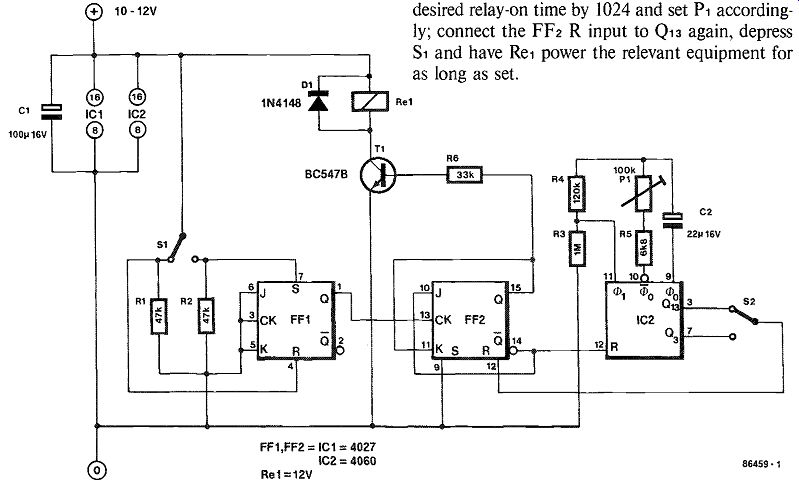
-------------
208 MAINS-BASED REMOTE CONTROLLER
This combination of transmitter and receiver is based upon the use of the mains network in the home for remote control of mains-operated domestic appliances.
Figure 1 shows the transmitter, which merely superimposes a 36 kHz signal on the 50 Hz mains voltage if S1 is operated. It is noted that IC1 is fed direct off the mains voltage by means of a rectifier circuit composed of Di, D2, zener diodes D3, D4, and smoothing capacitor C4; the proposed con figuration is to supply + 20 V with respect to the mains neutral (0) line. The 36 kHz output signal of the opamp is fed to the mains by means of coupling capacitor C3. R2 is a bleeder resistor to discharge C1 and C2 after the circuit has been unplugged from the mains outlet.
The receiver, shown in Fig. 2, is fed with an inexpensive door bell transformer, although any other type supplying 6 to 8 V AC at about 300 mA should do just as well.
Apart from being used to power Tr1, the mains voltage with the 36 kHz carrier is filtered by parallel tuned circuit L1-C6 to detect the presence of the superimposed 36 kHz carrier, which is passed to amplifier IC1 via R7. Subsequent rectification by D9 enables the relay driver circuit composed of T1 and T2 to energize Re1. Preset Pi is adjusted to find the right compromise between receiver sensitivity and noise immunity. R14 should be dimensioned to suit the relay coil current.
As to the construction of the receiver and transmitter, it should be made quite clear that the presence of the mains voltage necessitates the use of sound and safe con-ABS enclosures to prevent accidental contact with the live wires. Do not take any risk in this respect, neither while experimenting with the circuits as shown nor while setting up and testing.
The transmitter, then, is readily fitted in a salvaged mains adaptor case with a small hole drilled into it for S1.
The receiver ABS enclosure is likely to be of larger size if a mains socket is incorporated for easy connection to the appliance to be controlled. The con tact rating of Re1 should be duly observed in case heavy loads, such as a coffee machine (4 A), are to be switched.

----------

---------
209 MAINS FAILURE ALARM
This circuit was originally developed to detect arid signal interruptions of the mains supply to artificial respiration systems. The signaling is done in two ways: a buzzer is sounded, and a small lamp is quenched.
The supply current to the monitored equipment induces a variable flux in a small transformer that serves to keep the relays actuated, so that Lai lights and Bz is off when the mains voltage is available.
When a mains failure occurs, apparatus X no longer draws current, so that both Re1 and Reg are de-actuated, resulting in the lamp being turned off, and the battery-operated buzzer being activated.
Transformer Tr2 is a modified 3 VA mains type which functions as a current transducer: the original primary winding functions in this application as the secondary, while the original secondary winding is replaced by about 7 turns of 20SWG (0 1 mm) enameled copper wire. Every precaution should be taken to ensure that the new winding is capable of safely handling the current demand of X. Thanks to the so created high turns ratio in the transformer, a relatively small current suffices to keep the relays actuated and the smoothing capacitors C1-C2 charged. Push-button S1 makes it possible to test the alarm by simulating the absence of induced current. Tr1 can be a small bell type, or one salvaged from a mains adapter for a pocket calculator. Switch S2, finally, is used to turn off the buzzer when apparatus X is disconnected or switched off.

---------
210 MAINS VOLTAGE MONITOR
It is often desirable to know at a glance whether the mains voltage is at the low side; for instance, when you are about to work on a computer program. The danger is, of course, that when it is already low, further loads may cause the mains to drop below an acceptable level.
The supply for the present circuit is taken direct from the mains, which exists across R1 and P1. The 15 V stabilized voltage produced by R2, C1, C2, D1, and D2 provides two reference voltages. These voltages are compared in A1 and A2 with a fixed proportion of the mains. If the mains is below 210 V, D7 lights, and when it is higher than 250 V, D8 lights.
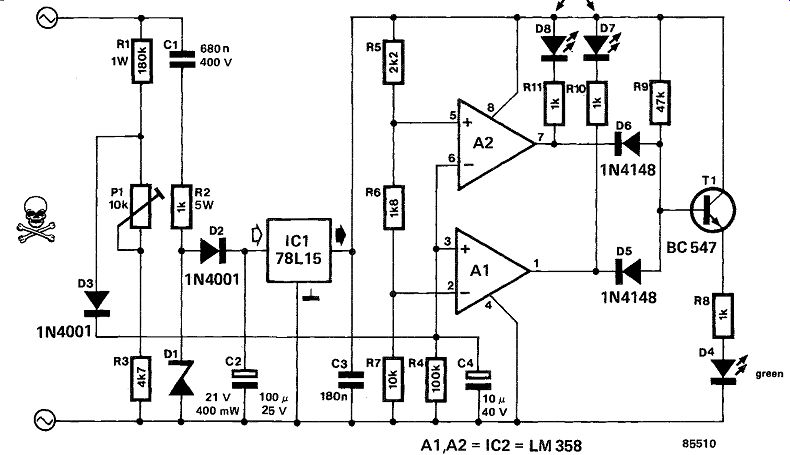
----------
When neither D7 nor D8 lights, T1 switches on and causes D4 to light, indicating that the mains voltage is within acceptable limits. The mains voltage limits are set with P1 with the aid of a multimeter and a variac; where perfectionism is not required, the preset may be set to roughly the center of its travel.
Remember that this circuit is not isolated from the mains and it must, therefore, be housed in a man made fiber case.
211 MAINS WIRING LOCATOR

-----------
The accompanying circuit shows a simple means of locating current-carrying conductors. The detector coil is a telephone pick-up with suction pad. The magnetic field of a current-carrying conductor induces a very small voltage in LA that is amplified in opamps A1 and A2. Capacitors C2. . a have a value which ensures maximum amplification in A1 and A2 of signals around 50 Hz. Diode D1 will light during positive halve-waves of the mains current.
212 METAL DETECTOR
In contrast to the other metal detector in this issue, the present one works on the principle that the frequency of an LC oscillator changes when the inductance is altered. Any metal object brought near the inductor will modify the inductance.
The degree by which the frequency changes depends on the nature of the metal and on the frequency. If the frequency is very high, a metal object will act as a shorted turn, which lowers the inductance, so that the frequency increases. If the frequency is low enough for eddy-current losses to be ignored, it is possible to distinguish ferrous from non-ferrous metals.
The inductance required for an oscillator frequency of not greater than 200 Hz would be pretty difficult to make, and the oscillator in the present circuit, therefore, works at about 300 kHz. The inductance then needed is quite easy to make and consists of a single turn of coaxial cable as shown in the accompanying diagram.
The circuit consists of oscillator T,, frequency-to-voltage converter IC1, and Bi-MOS operational amplifier IC2. With a detector coil diameter of c.
440 mm, the values of capacitors C1 and C2 ensure an oscillator frequency of around 300 kHz. Smaller diameter coils need more turns.
The level of the oscillator signal should be at least 500 mVitit to be able to drive the 4046B satisfactorily. At that level, the phase comparator ensures that the internal phase-locked loop always locks.
The source follower output at pin 10 is fed to a CA3130 where it is amplified substantially.
The center frequency of the phase-locked loop, and, therefore, the zero of the center-zero microammeter, is set with P1; fine adjustment with P2 may be necessary if the sensitivity of the opamp is high.
That sensitivity is set with P3 which is connected in the negative feedback loop to the inverting input.
There is also positive feedback via the microammeter and R10 to the non-inverting input. If, therefore, a meter with a different resistance is used, it may be necessary to alter the values of R9, R10, and R11 accordingly.
Note that in treasure hunts the size of the objects sought should have some relation to the diameter of the detector coil: looking for coins with a 440 mm (17.5 in) diameter coil is a fruitless task!
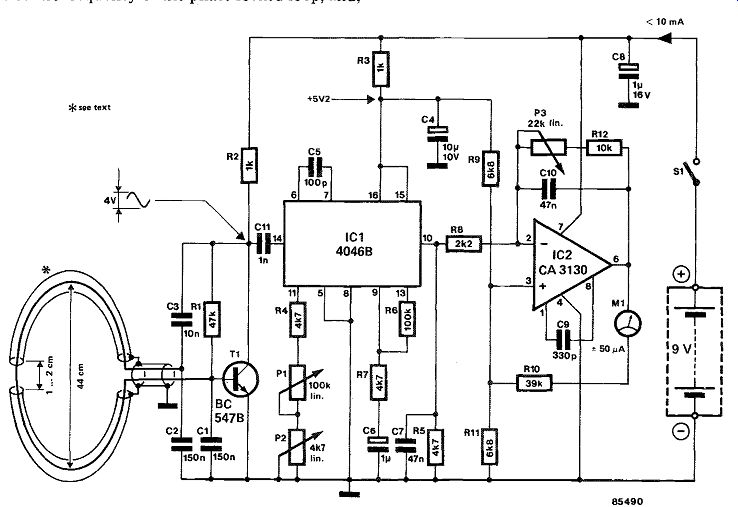
----------
213 METAL PIPE DETECTOR
Water and gas pipes, as well as electrical conduit, embedded in walls are not easy to trace, although this is essential when work is to be carried out to the wall. This handy little unit will be a godsend at such times.
The principle of the detector is based on the property of metals of absorbing magnetic energy when they are brought into a magnetic field.
Transistor T1 in figure 1 is a simple LC oscillator, of which the sensor, L1, forms a part. The oscillator frequency is around 15 kHz. When energy is withdrawn from the magnetic field around L1 by a metal object, the alternating voltage across the LC circuit will diminish. By rectifying that voltage in IC1, and applying the resultant direct voltage to a differential amplifier, IC2, which compares it with a voltage preset with 134 an on/off indication is obtained. When L1 is brought in the vicinity of metal, D4 goes out. The sensitivity of the detector is set with P1 and Pa
The unit is powered by a 9 V battery (PP3).
To calibrate the detector, adjust Pi for maximum resistance and connect an oscilloscope to the collector of T,. Adjust the peak value of the oscillator signal with P2 so that the oscillator just does not stop working. This is checked by adjusting Pa so that the LED just lights. If then a coin is held near the ferrite rod, the LED should go out, indicating that the oscillator has ceased working.
At the start of the search, use the smallest peak value of the oscillator signal (P1 at maximum resistance), combined with the lowest trigger level (wiper of P3 to earth). After the location of the pipes has been ascertained roughly, the peak value of the oscillator signal and the trigger level can be increased until the required accuracy is obtained.

---------------
214 MINIATURE RUNNING LIGHTS
The type UAA170 integrated circuit is normally used to drive up to sixteen LEDs, and the present circuit is no exception, as can be seen from figure 1.
The 555 is used as an astable multivibrator, but note that its output is not connected to the UAA170. Instead, the driver is fed from the junction of an RC network with a triangular voltage, the period of which is set with Pa It is advisable to use a tantalum capacitor in the C7 position to keep the leakage current down.
The voltage at the input of IC2 must not exceed 6 V. To ensure that the triangular voltage remains below that value, the supply voltage of IC, is limited to 9.1 V by D17. If necessary, this zener di ode may be replaced by an 8.2 V or even 6.8 V type.
The voltages on pins 12 and 13 determine the voltage range swept by the LEDs.
The reference voltage for D-16 is provided via pin 5 of IC, and amounts to about 3/4 of the supply voltage to the 555. The reference voltage for D, is determined by the potential at the junction of 85451 R4-R5 ( = pin 12 of IC2), which with values shown amounts to about 3 V.
Current consumption is around 30 mA, so that battery supply is only possible with two PP3s in series and a 12 V regulator.
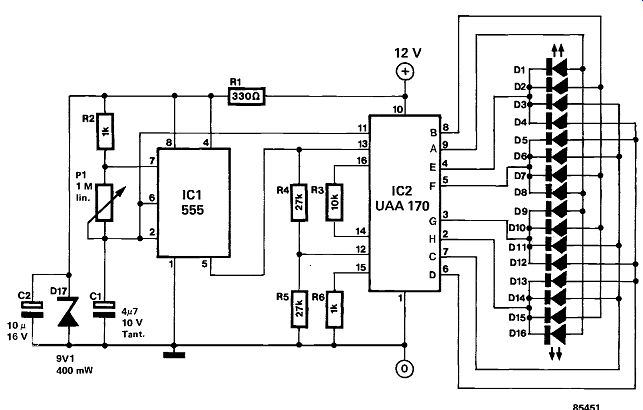
-----------
215 MUSICAL GREETING CARDS
The designer of this circuit will readily admit that it is literally not much to make a song or dance about, since what is shown as the circuit diagram speaks (sings) for itself.
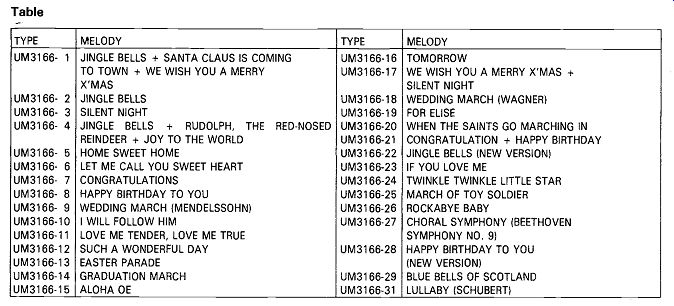
--------- Table
Available in about 30 different song versions, the Type UM3166-xx is a fully autonomous melody generator chip which operates at extremely low battery voltages (1.3. . .3 V), while capable of directly driving a small piezo-buzzer from antiphase output terminals 2 and 4. If you wish, you may connect an AF amplifier to either of these pins in order that more listeners may be captured by the melody selected from the accompanying table. The melody may be played continuously by connecting terminal 3 to 7 rather than 1. (St)
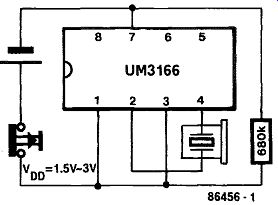
-----------
216 RANDOM LIGHTS CONTROLLER
Unfortunately, we are all well aware that the annual holiday season is an anxious time for many people, since they worry about leaving the home unattended and therefore liable to be visited by burglars and/or hooligans. Right now is, therefore, an ideal time to construct this circuit before you leave your home and all of your highly-valued property.
It goes without saying that simulating one's presence in the home may be accomplished by having some electronic or mechanical timer device switch on a number of lights when it grows dark, merely keeping them on until a fixed time interval has lapsed. The potential housebreaker, however, may soon detect the regular pattern that occurs every evening, encouraging him to embark on his nefarious activities, since he realizes he is dealing with a harmless timer rather than persons in the home.

-----------
This circuit, while also being a timer, offers a better simulation of human activity, since it automatically arranges for a number of lights to be switched on and off in an apparently random manner, which gives the burglar the impression that there are people at home. In actual fact, the lights pattern is pseudo-random, but 16 possible configurations are bound to ensure sufficient diversity to keep your mind at ease and that of the attentive burglar quite puzzled for at least a few weeks.
And now for the operational principles of this easy-
to-build circuit. The evening's specific lights con figuration is determined by the four-bit logic code supplied by counter IC2 at the moment it becomes dark. Since this never happens at precisely the same time every evening, IC2 may be considered as a four-bit (1 of 16) random code generator. Whenever the LDR fails to detect the presence of daylight, the output of N2 goes high, and D1 charges C1. Mean while, Ni constantly applies 100 Hz pulses to the input of counter IC2. When the voltage across C1 and R2 has risen to a level, sufficiently high to be recognized as a logic one by the clock input of quad latch IC3, the four-bit counter code is latched and transferred to the Q0... Q3 outputs of IC3. In addition, N3 simultaneously enables IC4 to start counting and dividing its on-chip generated clock signal.
The latch (IC3) and counter (IC4) outputs are combined in AND gates N9.. .N16. The oscillator parts to IC4 R4 –P1 –R5-C3 (the latter is a bipolar type which may be substituted by two series-connected electrolytic capacitors) have been dimensioned such that output Q10 produces 15-minute long, 50% duty factor pulses; this interval may be set accurately by means of P1. Since IC4 is a binary (2n) divider, outputs Q1I2, Q13 and Q14 provide pulse period times of 60, 120 and 240 minutes respectively.
Whether or not these pulses can appear at the out puts of N9. . .N16 depends on the current logic level of each of the associated latch outputs Q0 . Q3. The AND gate outputs have been paired in four OR gates Ns. Ns; therefore Ns and N7 may supply either 15, 60, or 75-minute intervals, while N6 and Ns cater for relay-on times of either 60, 120, or 180 minutes; longer times (e.g. 360 minutes) are not feasible since N4 resets IC3, five hours (Q12 AND Q14 = 60+240 = 300 min.) after it fell dark at the LDR mounting position.
It is seen that Re1 and Rea are therefore best used for those lights that can be expected to go on and off for relatively short periods during the evening, while Reg and Rea are energized for longer times at later hours that same night.
Finally, the inset timing diagram illustrates the pulse sequence relevant to the four relay outputs.
217 REMOTE CONTROL FOR LIGHT SWITCHES
- PART 1
We all sometimes wish that some of the switches around the home were just a little easier to locate and operate, notably so in the dark and with less frequently used light switches, such as those for the cellar or garage light. For the physically handicapped, some switch locations present a real hindrance to their mobility in the home; for them, it would be very convenient to be able to operate the switch from a distance.
The proposed wireless control system differs from, say, an IR-based set-up in that it requires no line-of-sight path between transmitter and relevant receiver, while the practicable operating range is of the order of a few meters.
The circuit diagram of the control transmitter shows an oscillator composed of Ti, T3 and T2, the latter transistor merely functioning as a switching device. The oscillator frequency is set at about 30 kHz by means of C5, C6 and L1: the latter consists of about 200 turns of 36 SWG (0 0.2 mm) enameled copper wire on a paxolin former to suit the diameter of 10 to 20 cm long ferrite rod, which may be salvaged from a discarded MW/LW pocket radio.
The tap on the coil is made at 20 turns from the earth connection.
In order to compensate for the relatively low radiation efficiency of the proposed transmitter aerial, the peak pulse voltage across C6 amounts to some 150 Vpp when the oscillator is turned on for 8 ms by T2, which is driven with an 18 Hz signal from IC1.
The pulsed mode operation of the oscillator ensures a relatively low mean power consumption of the battery-operated transmitter when a receiver unit is to be activated.
Testing the transmitter is readily done with a scope; observe the pulsed 30 kHz carrier, which should look as indicated by the inset signal waveform drawing; the pulse-on time of 8 ms is determined by C4-R4, and their values had better not be changed, since they are the optimum compromise between transmitter current consumption and output power.

---------
218 REMOTE CONTROL FOR LIGHT SWITCHES--PART 2
Just like the associated hand-held transmitter (see previous article), the receiver is simple to construct.
As can be seen from the circuit diagram, parallel tuned circuit L1-C, receives the transmitter signal, which is first buffered by means of a dual gate MOSFET- T1- in order to prevent excessive loading of the tuned circuit. Further amplification is performed by T2, before rectifier circuit D1-C6 can provide a pulsating voltage to T3 which drives PLL detector IC, with a sawtooth-like signal. The lock output-pin 8-of IC, controls Re1 via relay driver circuit T4-Ts. As to a few details concerning the receiver circuit, the PLL chip signals the lock condition by pulling pin 8 low; C14 is charged and functions as a buffer device in case the PLL input voltage disappears because of the fact that the transmitter coil is no longer held steady for optimum reception (directive effect of the ferrite rod). At the receiver input, R should be mounted direct at the relevant MOSFET gate so as to prevent possible oscillation tendency of Like the transmitter coil, L1 is wound on a 4 cm long paxolin former, which can be slid over the ferrite rod to find the position that gives optimum reception. Use 210 turns of 36 SWG (0 0.2 mm) enameled copper wire; the coil length should be about 3 cm. L1 and L2 should be separated from each other with a metal screen to preclude stray coupling.
The receiver is readily tested and adjusted by placing an operative transmitter at a distance of about 4 meters. The optimum position of the coil on the ferrite rod can now be found by connecting a scope to the drain of T1 and sliding L1 for maximum received signal. In the absence of an oscilloscope, the signal at the PLL input (pin 3) may be connected to a loudspeaker to position L1 for maximum voice coil movement at 18 Hz. After it has been positioned correctly, L1 may be glued into place on the rod.
Adjusting the PLL is done with PI, which should be turned carefully across its travel to establish the points at which the PLL fails to lock on the incoming signal (Re, is deactivated and the lock indication LED, if fitted, goes out). Now set Pl to the position in between the no-lock points. Carefully maneuver the transmitter to a place where reception is worse, i.e. where Re, is observed to go off. Careful adjustment of Pl and further trial and error will enable the user to establish the preset position that corresponds to optimum receiver sensitivity and re liability under less than favorable circumstances.

-----------
219 RODENTS DETERRENT
There are a number of well-founded arguments against the use of poison to get rid of mice, rats and other rodents in and around the home. From an ecological point of view, the undesirable side effects are mainly the disturbance of the natural food chain of animals we do not wish any harm whatsoever; most poisonous substances devised to exterminate mice are, unfortunately, quite difficult to break down compounds, which may, in the end, be come manifest as dangerous to our own health.
The ecologically accepted method of getting rid of a population of mice is, therefore, based on the con trolled introduction of such predators as cats and owls, causing a high degree of stress on part of the mice, which are then quite quick to leave the relevant premises or area.
Another method of bringing about a high degree of stress is to produce a high-pitch, frequency-swept signal just above the audible range for human beings. The signal is swept rather than of constant frequency in order to prevent mice from becoming immune to the sound.
The proposed rodents deterrent is based upon the Type 555 timer chip, which is configured to produce a 20 to 40 kHz output signal, swept at a 50 Hz rate.
The latter frequency is obtained from the mains by means of C4 and R3, which pass the modulating signal to input pin 5. The output of the swept oscillator is connected direct to a high-efficiency piezo ceramic horn tweeter, which ensures a sufficiently high sound pressure level to keep rodents out of reasonably sized areas, such as attics and garages.
The completed rodents deterrent circuit, along with the tweeter, may be mounted in a simple ABS enclosure, but care should be taken to observe the directivity of the loudspeaker when fitting the unit in its final position.
Parts list
Resistors:
R1=1 k
R2;R3=15 k
Capacitors:
C1 =1 n
C2=1µ;16 V electrolytic
C3=10 n C4=220 n C5 = 1000µ;16 V electrolytic
Semiconductors:
D1 . . = 1N4001 IC1 =555
Miscellaneous:
Tri =6 V;200 mA.
TD1 = piezo horn tweeter.
Fi =50 mA, fuse, slow.
Fuseholder, PCB type, for Fi.
PCB Type 86490 ABS enclosure for wall mounting.
-----------


220 SET POINTER
Aneroid barometers invariably have two pointers:
one that is operated by the mechanics, and one that is set manually. The manually set pointer is really nothing but a mechanical memory that enables variations in barometric pressure to be ascertained.
The set pointer can, of course, be made electronic, for which a slide potentiometer is ideal. Such a pointer is not restricted to a barometer: it can also be used with a thermometer, a hygrometer, a battery that needs to be monitored; in short, with any sensor that delivers a slowly varying voltage.
The circuit consists of an amplifier, IC1, and a display stage, IC2. The display consists of between 3 and 9 LEDs, the center one of which, D5, is yellow and represents the point of origin. Potentiometer Pi can be adjusted to make this LED light. When the input voltage rises slightly, D6 (the color of which depends on the application) lights; when it drops, D4 (again, the color depends on the application, but it should be different from D6 . . D9) lights.
Greater variations in input signal cause D7 ... D9 or D3 ... Do respectively to light. It is at all times possible to adjust P1 in a manner which causes the center LED to light.
The potentiometer could be provided with a graduated scale to enable the input voltage to be read direct. It is not difficult to produce such a scale.
Apply voltages of 0.1 V, 0.2 V, and so on in steps of 0.1 V, and for each voltage turn P1 till the center LED lights. At each of the positions of P1 so found, draw a thin line.
The sensitivity of the circuit is of some import, because about 1 V is necessary at pin 5 of IC2 to make D1 and D9 light. As the amplification of IC1 is unity (R4/R3), about 1 V is, therefore, also needed at the input of the circuit for these LEDs to operate.
Opamp IC, deducts the voltage at the wiper of P1 from the input signal, and adds the potential at the junction of R5 and Re to the result.
Since P1 is connected to the reference voltage (1.28 V), only this voltage can be compensated for.
Strictly speaking, there is no reason why P1 should not be connected to the positive supply line in series with a suitable resistor. In that case, the display is only stable if the supply line is well regulated.
If the input sensitivity is too low, the values of R4 and R2 may be increased; note, however, that these values should always be the same.
Current consumption is determined primarily by the current through the LEDs, and that in itself is about ten times the current through R5 and R6. The latter current is equal to the on-chip reference voltage of 1.28 V divided by the total resistance of R5 +R6. The maximum current through the LEDs is about 40 mA (the current via pin 7 must not exceed 4 mA!) so that the total current does not exceed 50 mA.
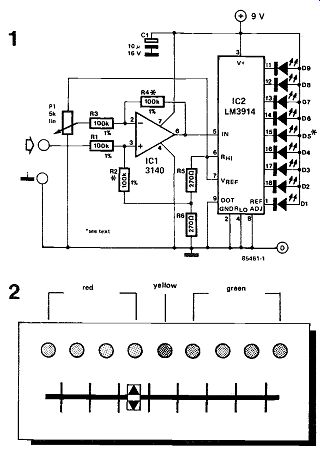
-----------
221 SIREN
In spite of its modest configuration, the circuit shown here is capable of generating quite a sound.
This is made possible by the n-channel MOSFET, which drives the loudspeaker.
Such a MOSFET can be driven direct by CMOS logic circuits, and the type chosen here has an out put ( = drain-source) resistance of only three ohms.
Moreover, its drain current can be as high as 1.7 A, while the maximum drain-source voltage is 40 V.
These parameters are independent of the polarity of the applied voltage, since the device has internal di ode protection.
Since the MOSFET is virtually indestructible, it is perfectly all right to load it with just a loudspeaker.
The circuit can be controlled simply from a computer, and is operated by making the ENABLE in put logic high (which can also be done with a simple switch instead of a computer). When the in put at pin 5 of gate N2 is high, the pulses from Schmitt trigger N, cause N2 to oscillate. The output of N2 is applied to the MOSFET via buffer N3. The frequency of N2 can be adjusted with Pi As to applications, this siren is particularly suitable for use in alarm installations.
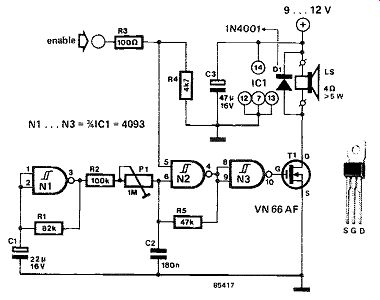
-----------
222 SMD DIE
"Alea iacta est" (the die is cast, freely) someone said quite a few years ago, and promptly engaged in sun dry military actions that are generally reported as having been decisive for global history. Whatever the relative importance of this notorious person's decision at that time, he is not likely to have employed a SMD die as described here, since he used the verbal form cast rather than a clausal construction (in Latin, of course) to indicate the presence of clock pulses from a Schmitt-trigger gate oscillator, at the relevant input of a Type 4029 binary counter which is preset to state 9 by means of jam (preset) inputs Jo . . . J3 while its Q0 . . Q2 outputs may represent 1 of 6 pseudo random states 9 . . .15 after removing one's fingers from the touch-sensitive contacts between oscillator and counter clock input.
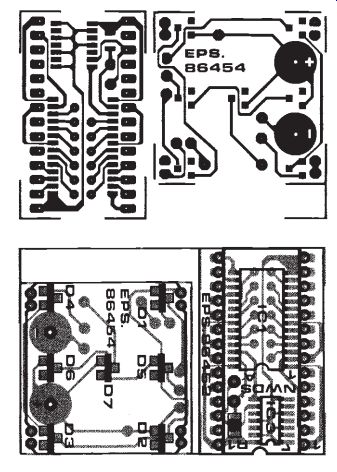
--------

--------
Parts list (all parts SMD)
Resistors:
R1;R2=100 k R3 . . R6=560 ohm
Capacitor:
C1=12 n
Semiconductors:
... D7 = LED Type CQV231 or LSS210D0 (Siemens)
IC1=4029
IC2=40106
Miscellaneous:
battery clips for PCB mounting
PCB Type 86454
9 V battery PP3
Counter output states 9 . . .15 were chosen rather than 1. . . 6 with the corresponding preset 1, in order that the CO (carry out) could be connected to PE (preset enable) via inverter N2. This arrangement causes the binary value at the Qe . . Q2 out puts to vary between 1 and 6, since Q3 is left unused. CO goes low any time the counter reaches out put state 16, which can not be represented by means of the four binary outputs to the IC (2^4=16).
Consequently, the counter loads the preset value 1 (9), since PE goes high.
LEDs D1.. . D7 are arranged in the form as usual on the "six" face of a die, and the random number is, of course, displayed as an imitation of the spot(s) seen on the cube faces.
As to the construction of the SMD die, the tiny parts are fitted onto ready-made, through plated PCB Type 86454, which comes together with the Type 86452 (sideway RAM for BBC and Electron, also a SMD project in this issue).
It is noted that the 9V battery is clipped direct onto the circuit board to make a compact unit with the LEDs facing up. The "cast" contacts are four lengths of stripped wire at the LED side of the PCB, mounted at all four sides. Placing your fingers onto either two of these wires facing one another causes all seven LEDs to light, while on release a pseudo random value is displayed.
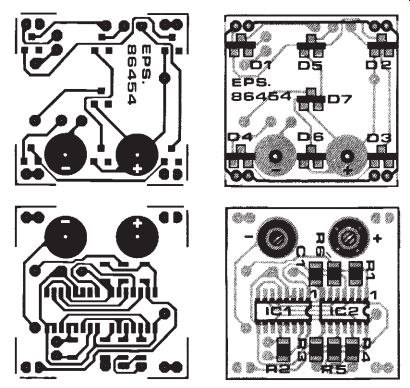
-----------
223 SMOKE AND GAS DETECTOR
---------
Table Hydrocarbons: iso-butane CH3CHICH5ICH3 n–butane
CH3CH2CH2CH3 ethane CH3CH3 propane CH3H8, CH3CH2CH3 methane CH4
Inorganic gases:
Organic solvents:
hydrogen H ammonia NH3 carbon monoxide CO ethanol CH3CH2OH acetone C3HBO, CH3COCH3 n-hexane CH3(CH214CH3 benzene C6H6
------------
This circuit is intended for use as a preventive device. We all know about accidents that occur through the accumulation of gas or of people over come by smoke. The preventive character manifests itself by timely warnings in case of high gas concentrations in a manner that does not cause the gas to explode.
The circuit is based on sensor type TGS109 which is sensitive to gases enumerated in the accompanying table.
Power is provided by an 8-volt bell transformer which is tapped at 5 V. The voltage developed across the 5 V winding is rectified by D3, smoothed by C,, and regulated by R2, D4, and C2. The resulting direct voltage of about 5.6 V is used to supply IC,. The 3 V alternating voltage is used to operate the sensor, which needs 1 V at about 0.5 A.
Resistor R1 provides the necessary voltage drop.
The mutual inductance between the two windings of the sensor increases with rising gas concentrations. Note that there is no difference in the two windings: the sensor may therefore be inserted into the socket in any way it fits. In practice, a rising gas concentration will cause an increased alternating voltage in the secondary winding of the sensor. This voltage is rectified in D1 and smoothed by C3; its level ( = sensitivity) is preset with P1 Diode D2 protects one of the inputs of N, against too high input levels. Gates N1-N2 and N3-Na are astable multivibrators which cause the buzzer to operate when there is too high a concentration of gas.
Resistor R3 serves to counteract changes in sensitivity caused by temperature variations.
The detector can be built into a small case, but bear in mind the heat dissipation in R1.
Finally, in case of an alarm, be careful in the inspection of the relevant room or space for which the alarm is sounded.
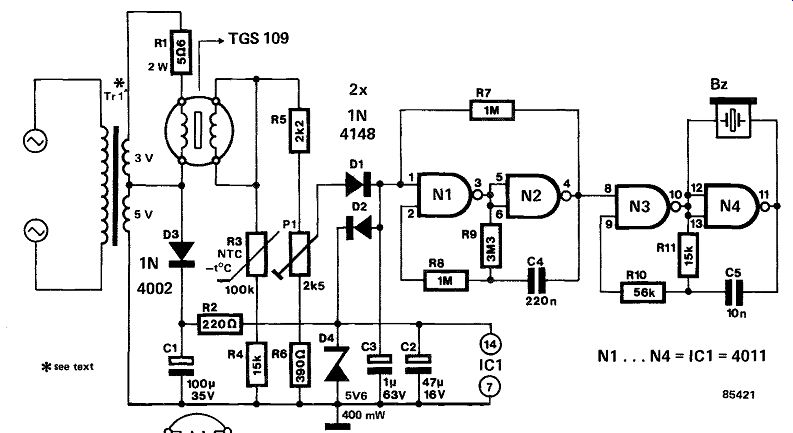
------------
224 STAIRCASE LIGHT CONTROLLER
This circuit has been designed to function as an automatic switch-off facility on the lines of the well known hotel switch circuit, i.e. the combination of two switches and a single light. While not exactly a replacement of any of the two changeover switches at the top and the bottom of the stairs, the proposed controller may be fitted into one of the relevant junction boxes in which a live mains line is available.
The circuit diagram shows that the controller is fed direct off the mains. C3 and R21 create a suitable series impedance which charges C4 to 6.8 V by means of rectifier D6 and zener diode D7. Set-reset bistable T3-T4 keeps track of the position of S2, which determines which of the two triacs is to be driven so as to turn the light on. Any time S2 is operated, timer IC1 is started by means of C1-R17, C2 Rts, N1, N2 and N3; the output of the latter goes high in this condition, resetting IC1 and causing it to pull all of its counter outputs low. Note that the reset condition can also be forced by depressing S1.
FET T5 is turned off at reset, and 50 Hz clock pulses are applied to the Phi_1 (clock input) terminal of IC1. Any one of the five timer outputs Q8 ... Q13 may be wired to the inputs of gate N4 to select the desired on-time for the light; longer intervals may be realized by adding a further counter.
When the selected light-on interval has lapsed, T5 conducts and disables IC1 from receiving clock pulses; the counter state is thus frozen until a reset pulse is applied at terminal 12. Finally, T1 and T2 provide DC control of the relevant triac, while AND gate simulators D1-D3-R3 and D2-D4-R4 en sure the correct selection of Tri1 or Tri2 to power the bulb.
The circuit is readily constructed on a piece of veroboard and fitted into an ABS mains wiring junction box, as a replacement of one of the switches in the hotel circuit.
As many points in the circuit are at mains potential, due precautions should be taken in the construction and wiring of the controller. Note that S1 should be rated at 240 V AC, in view of the necessary isolation with respect to the mains voltage.
Tri1 and Tri2 require no heatsinks if the bulb is rated at 100 W or less, while the maximum power rating for the triacs is about 400 W.
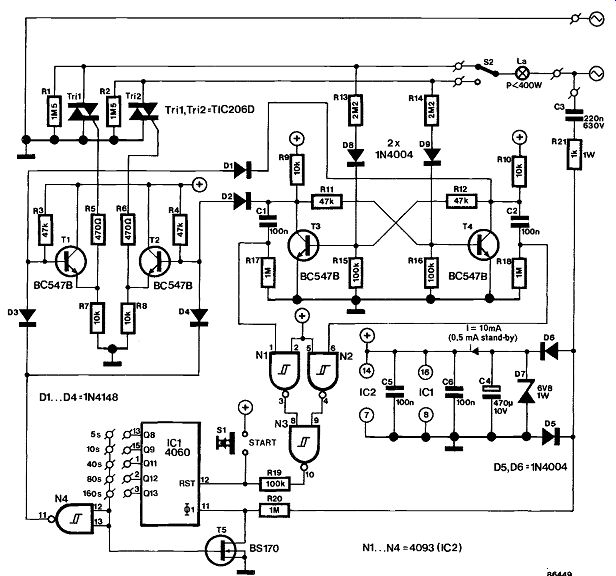
------------
225 SUPER DIMMER
Most dimmers use a silicon-controlled rectifier (triac or thyristor) which is triggered at a fixed phase angle and then conducts until the next zero crossing of the mains voltage. This method simple, but at the same time it gives problems in controlling small or inductive loads (hysteresis; flickering). The cause of these problems lies in the fact that owing to small load the current supplied to the bases is insufficient to allow conduction to continue. This means that a region of the control characteristic is not used. The effect is even worse when the load is inductive.
The proposed circuit offers a solution by providing the SCR continuously with gate current, so that even loads of 1 watt can be controlled. To keep the circuit as small and simple as possible, it makes use of the well-known timer-buffer Type 555.
The output of the 555, which is normally active high, is made active low with the aid of a negative supply voltage. The supply is provided by network CI-R3, rectifier D1-D2, and stabilizer D3-C2. Transistors T1 to T3 provide a start pulse at the trigger input of the 555 during the zero crossings of the mains. For a period determined by the setting of P1 and P2, the output of the timer is high, and there is, therefore, virtually no potential difference between pins 3 and 8, i.e. the SCR is turned off. When the set period has lapsed, pin 3 goes low and the SCR is triggered. For the remainder of the half period, a gate current flows which keeps the SCR in conduction. The minimum position at which, for instance, a light bulb should just not light, is set with P1.
Filter R7-C5-L1 provides the requisite decoupling of the SCR.
Finally, note that the maximum power that can be controlled is of the order of 600 watts.
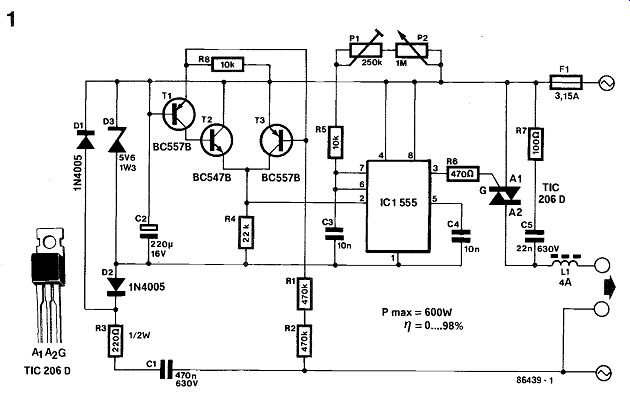
-------------

------------
226 TELEPHONE-BELL SIMULATOR
This circuit is intended for use in a small private telephone installation. The ringing tone sequence is 400 ms on, 200 ms off, 400 ms on, 2 s off.
In the accompanying diagram, Ni and N2 form an oscillator that operates at a frequency of 5 Hz, which gives a period of 200 ms. The oscillator signal is fed to two decade scalers, which are connected in such a manner (by N3 and N4) that the in put signal is divided by 15.
The second input of N4 may be used to switch the divider on and off by logic levels. If this facility is not used, the two inputs of N4 should be interconnected.
Resistors R3 to R6 incl. form an OR gate that controls a relay via T1 and T2 which are connected in a darlington circuit.

---------
Outputs 5 to 9 of IC2 go high sequentially, so that the relay is energized for 400 ms (when 5 and 6 are high), then off for 200 ms (output 7 is not connected), and then energized again for 400 ms (when 8 and 9 are high). After that, the relay is off for 10 periods = 2 s, and then the cycle repeats itself.
227 TEMPERATURE REGULATOR WITH ZERO CROSSING SWITCH
This temperature regulator can be built without special ICs and may be used with powers up to 3.5 kVA.
The circuit is based on a two-point regulator with a thermistor as the temperature sensor. As the load current is switched only during zero crossing of the mains, no additional interference suppression is necessary.
The series combination RIC, serves to lower the mains voltage to a level suitable as supply voltage for trigger T,. As R is small compared with the reactance of C,, the current leads the voltage by nearly 90°.

-----------
If the ambient temperature is higher than a given value, determined by potentiometer P1, the resistance of Rth is low enough to cause T1 to conduct.
Silicon controlled rectifier Th1 is supplied with gate current and switches on during the negative half cycle of the mains, because the current through R1C1 leads the voltage. When Th1 is on, thyristors Th2 and Th3 remain in the blocked state, so that no current flows through heating element RE When the temperature drops below the value deter-mined by P; transistor T1 and thyristor Th1 remain off, so that Th2 conducts. As the voltage across zener diode D1 leads the mains voltage, Th2 switches on when the remains crosses zero. At the onset of the negative half cycle, Th3 switches on.
During the positive half cycle, C2 is charged via R7 and D2, and so provides the gate current to switch on Th3 at the onset of the negative half cycle.
228 TEMPERATURE SENSOR
The LM35 is a temperature sensor which provides an output voltage that is directly proportional to the temperature being measured in degrees Celsius.
This means that if the temperature is 0 °C, the out put voltage is 0 V. The output voltage increases by 10 mV for every degree Celsius, i.e., at 19.8 °C, the output voltage is 0.198 V.
This is an important advantage over other tempera ture sensors that are calibrated in kelvin. Using such sensors to measure in degrees Celsius requires a very stable reference voltage that must be deducted from the reading.
Another advantage of the LM35 is its very low current consumption of less than 60 µA. This means a long battery life and small internal power dissipation, so that errors caused by internal heat are minimal: 0.1 °C with a battery voltage of 4 V.
The sensor can be connected direct to an analog or digital multimeter, or, more interestingly, to a computer which can then process and store the in formation. A suitable interface for this purpose is described in direct reading digitizer elsewhere in this issue.
The accuracy of the LM35/LM35C is typically 0.4 °C at 25 °C.
To keep the self-heat minimal, the load should be not smaller than 5 k-Ohm.
If a long screened cable is used between the sensor and indicator, an RC network (10 ohm in series with I µF) should be connected between the output of the sensor and earth to prevent any oscillations.
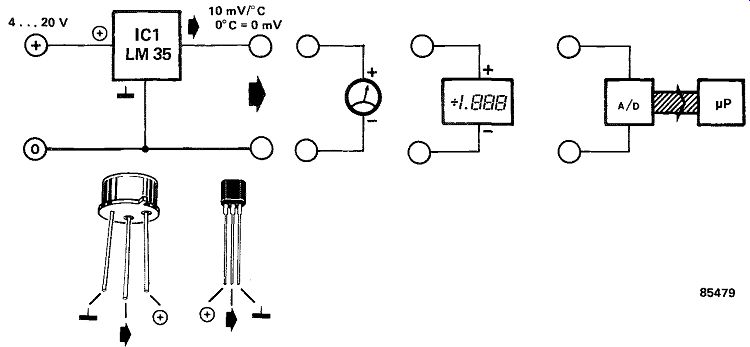
------------
229 THERMOMETER
At the heart of this simple circuit is the well-known Type KTY10 temperature sensor from Siemens. This silicon sensor is essentially a temperature-de pendent resistor, which is connected as one arm in a bridge circuit here. Preset P1 functions to balance the bridge at 0°C. At that temperature, moving coil meter Mi should not deflect, i.e., the needle is in the center position. Temperature variations cause the bridge to be unbalanced, and hence produce a proportional indication on the meter. Calibration at, say, 20°C is carried out with the aid of P2.
The bridge is fed from a stabilized 5.1 V supply, based on a temperature-compensated zener-diode. It is also possible to feed the thermometer from a 9 V battery, provided D1-D3, R1 and C1 are replaced with a Type 78L05 voltage regulator, because this is more economic as regards current consumption.
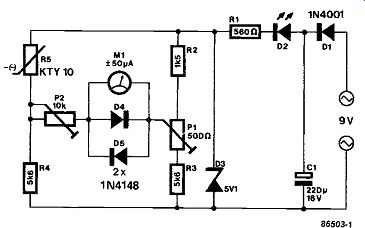
----------
230 THERMOSTAT-CONTROLLED SOIL HEATING

-----------

------------
Many people with a keen interest in growing plants insist on the fact that many of the more exotic species, such as certain species of orchid and fungi, will only thrive in warm soil and relatively high humidity.
Whether or not this is a correct assumption, this circuit offers the possibility to keep the soil tempera ture in a miniature hot-house at a constant, adjust able level.
The heating element is made of several loops of plastic covered steel wire, such as used in gardening.
The wire used in the prototype had a diameter of 1 mm and a resistivity of about 0.2 ohm per meter.
The circuit diagram of the soil heater shows that the heating element is temperature controlled by means of a triac, driven by a Type TDA1024 electronic thermostat which gets the necessary information as to the soil temperature from R6, an NTC type sensor.
The circuit is fed from the transformer secondary by means of rectifier D1 and series resistor R2.
Regulation at 6.5 V is internal to the IC, and C3 smoothes this voltage. R3 and R4 provide the IC with a mains synchronizing signal, while C1 causes a controlled phase shift in order that the relatively low operating voltage can still ensure the correct zero-crossing synchronization.
The temperature sensor circuit is composed of R5, R6, and P1. The sensor proper, Rs, must be placed into the soil at a suitable position, electrically well isolated, of course. The optimum soil temperature, which should be established by trial and error, is adjustable with preset P1; Fig. 2 shows the correlation between soil temperature, heating element voltage, and preset temperature.
If necessary, a more powerful heating element may be dug into the soil, but the ratings of the fuse, Tr1 and Tri1 should then be changed accordingly. The transformer secondary voltage, however, should re main at 9 V. With the components as indicated in the circuit diagram, the heating energy is about 40 joules.
231 TWIN BELL-PUSH

------------ It is often desirable for a single doorbell to be operated by two bell-pushes. for instance, one at the front door and the other at the back-door.
The additional bell-push, S2, in series with the break contact of relay Re), is connected in parallel with the original bell-push, Si. When S2 is pressed, the bell voltage is rectified by D1 and smoothed by G.
After a time T = R1R2C2, the direct voltage across C2 has risen to a level where T1 switches on. Relay Re, is then energized and its contact breaks the circuit of S2, so that the bell stops ringing. After a short time, C1 and C2 are discharged, the relay returns to its quiescent state, and the bell rings again.
In this way, S1 will cause the bell to ring continuously, while S2 makes it ring in short bursts, so that it is immediately clear which bell-push is operated.
232 TWIN DIMMER
Dimmer circuits are always popular and this one offers two independent controls in one.
Control of each section of the circuit is provided by a type S576 which is an improved version of the S566. This type of IC controls the phase gating by short or long command pulses emanating from a touch pad. Pulses shorter than 60 ms are treated as noise.
Short pulses between 60 ms and 400 ms cause the lamp to be switched on or off, depending on whether it was off or on respectively.
If the touch pad is touched for more than 400 ms, the appropriate lamp is dimmed at a certain speed.
If the finger is held on the touch pad, the lamp will go out completely and will then slowly light up again: when it reaches full brightness (and the finger is still on the pad), it will begin to dim again, and so on.
The 5576 is available in three versions: A, B, and C.
With the A and C versions, the lamp is always switched on or off half-way between maximum and minimum brightness, and it first attains maximum brightness before it can be dimmed. The B version is interesting in that it remembers the last brightness level, so that the lamp is always switched on or off at the last brightness setting. These various possibilities are summarized in figure 1.
The circuit of the twin dimmer is shown in figure 2.
Power for the ICs is provided via R2, Ca, D1, and D3. The supply is smoothed by C7. Capacitors C3 and C6 determine the speed with which the lamps dim or get brighter.
The twin dimmer is best built onto the printed circuit board shown in figure 3. This board is intended to be fitted into a standard round junction box.

------------
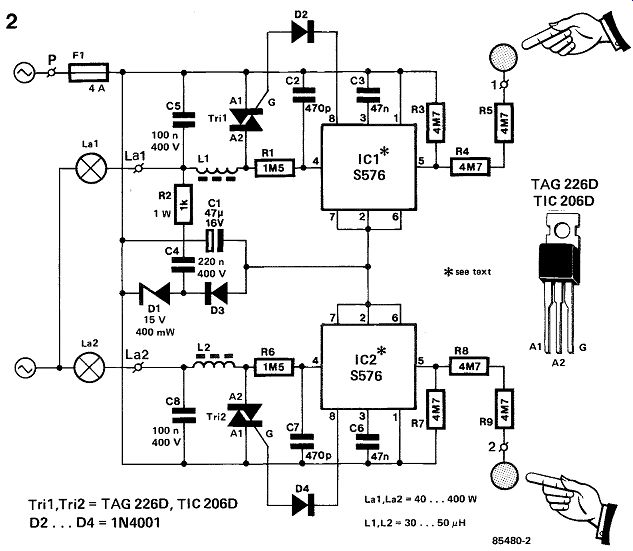
-----------
Because of this, it is, of course, important that the components used are of the correct size as shown on the board.
The board is connected to the lighting system via three terminals: L to the live wire, and S1 and S2 to the switching wires of the lamps. The junction of the lamps is (already) connected to neutral.
Note that the dimmer cannot be used with neon tubes.
Parts list:
Resistors:
R1,R6 = 1M5
R2 = 1 k/1 W
R3 . . R5,R7 . . R9 = 4M7
Capacitors:
C1 = 47 µ/16 V C2,C7 = 470 p Ca,C6 = 47 n ceramic C4 = 220 n/400 V C5,Cs = 100 n/400 V
Semiconductors:
D1 = zener diode 15 V/400 mW
D2 . . . D4 = .1N4001
IC1, IC2 = S576 (see text for which version)
Tri1,Tri2 = TAG226D or TIC206D
Miscellaneous:
L1, L2 = 30...501.4F1/2 A
= fuse, 4A, delayed action and associated PCB holder 1 three-way ceramic terminal block (5 A)
PCB 85480

-----
233 TWO-TONE-CHIME
This electronic chime is easily built from commonly available, inexpensive parts.
Depression of the door bell button, S2, causes inverter T1 to pass a logic low level to NAND gate N1, which responds with a logic high level at its output, enabling the oscillator composed of N2 and N3 to toggle at about 1 Hz. Since buffer capacitor C1 remains charged for some time after S2 has been released, the oscillator will continue to provide 1 Hz pulses to C4 and C5, as well as to a second oscillator section, composed of N4 and associated parts via R6.
A logic high level at pin 10 of inverter N3 enables T2 to connect preset P2 in parallel with frequency determining parts R7-P1, which arrange the frequency of N4 to toggle at a few hertz. The two superimposed frequencies may be adjusted to individual taste with P1 and P2.
In addition to controlling the tone frequencies of the chime, the 1 Hz pulses also determine the envelope shape of the resultant chime sound by means of T4-Ts and associated parts. Preset P3 is used to define the desired decay characteristic, while emitter follower T6 functions as a very simple voltage-controlled amplifier, driving one-chip AF output amplifier Type LM386.
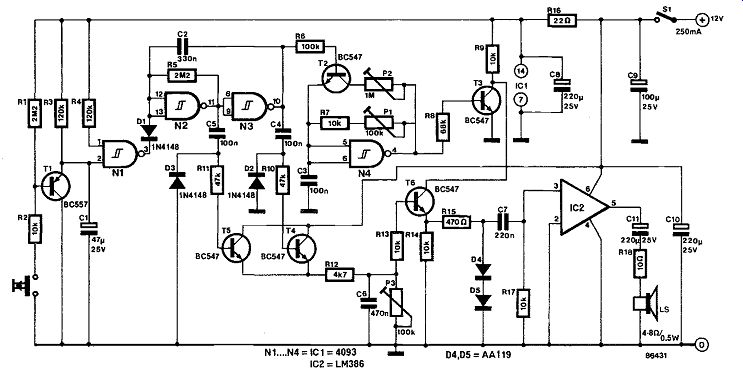
----------------
234 VENTILATOR CONTROL
Many toilets have a ventilator, which is energized along with the toilet light. However, since not every visit of the toilet requires the ventilator to start turning, this circuit offers an improved control method, which is still based upon the use of the light switch.
The circuit configuration marked I in Fig. 1 may be used in case the toilet ventilator is powered from the same mains lines as the light. Bridge rectifier Bi and opto-coupler Type TIL113 serve to detect whether or not the toilet light is on. The ventilator is arranged to start turning after the light switch has been operated twice. If this is the case, the output of NI will go high twice; the first time, C4 is charged, the second time will cause pin 6 of N2 to be logic high, while the output of this NAND Schmitt trigger gate will supply a logic low pulse to N3 when the voltage at point 3 reaches the logic one level (see timing diagram Fig. 2). N3, then, charges Cs which, along with P2 and R9, deter mines the ventilator "on" interval, while Pi, C4 and R8 establish the maximum interval between the reception of first and second trigger pulse.
The circuit option with T2 may be used if it is less desirable to run an additional wire to the light for the purpose of obtaining the trigger pulses; the LDR should be located as close as possible to the bulb in order to preclude erroneous triggering due to the presence of daylight. The use of the LDR does not change the basic operation of the circuit, of course, and the indirect method of triggering is in fact to be preferred in view of the risk associated with direct mains connection in the case of the first mentioned circuit option.
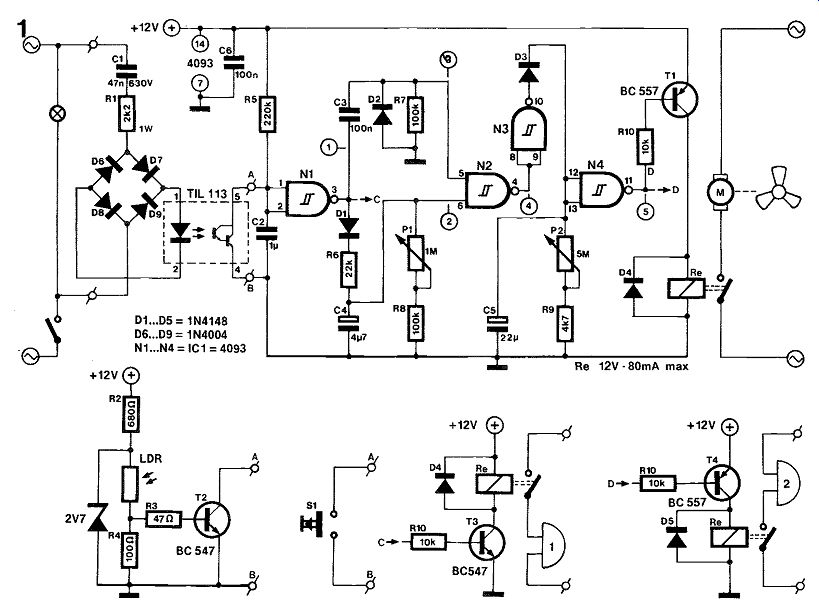

--------------
Another interesting use of the circuit option which incorporates S1, T3 and T4 is a semi-intelligent door bell arrangement; bell I will sound any time S1 is depressed, while bell 2 will only do so if the button is operated twice within the given interval; it is not difficult to come up with a number of useful applications for this circuit when used in and around the home. However, note that the timer parts Ca, Pi and R8 will have to change places with Cs, P2 and R9 respectively, if the second bell is to be kept from sounding for about 50 seconds after S1 has been operated twice.
The power supply for the circuit may be of conventional design, incorporating the ubiquitous 78xx type of regulator. Current consumption of the circuit is mainly dependent on the type of relay, but 50 to 180 mA would appear to be a typical value.
-----
235 WATCHDOG
This timer automatically switches off equipment left operating unattended for more than about thirty minutes.
The circuit operation is readily understood by following its power-on and time-out functions. Almost immediately after S4 has been depressed, relay contact rely closes to power Tr1 and the equipment connected to the mains outlet. This happens because the initial presence of the +12 V supply voltage in the circuit causes counter-oscillator IC1 and set/reset (S/R) bistable N1-N2 to be reset by means of a short, logic high pulse at the junction of R1 and C1. The outputs of Ni and N3 go high and low respectively and Ta can energize Re1. So far for the power-on automatic hold function of contact relay.
After being reset, IC1 starts counting down its on-chip generated clock pulses which have a frequency of about 2 Hz. LED D1 flashes at this rate to indicate the countdown condition. Note that S2 has been provided to reset, i.e. disable the timer permanently, in which case D1 lights steadily. The LED, therefore, has a threefold indicator function in the present circuit: timer on (flashing), timer and equipment off (off) and timer off while the equipment is on (steady light).
As long as counter output Q12 remains at logic low level, the voltage at the collector of Q5 inverter T2 can not cause the relay coil current to be interrupted by T4. If, however, some 34 minutes [T(Q12) = 1/2 x 2^12= 2048 s] have lapsed since IC1 and N1-N2 were reset, Q12 goes high, causing the two-gate bistable to toggle; the output of N1 goes low, but Re1 remains energized by Ta, since the other input of NOR gate N3 is still high, i.e. counter output Qs has not been set as yet. The self-oscillating buzzer starts sounding at a 2 Hz rate, however, since T3 is driven by NOR gate Na which receives two logic low levels at its inputs. The user is thus notified that the has another 15 seconds or so left to depress S1 for another 34-minute interval. If no such action is taken to reset the timer before Q5 goes high, N3 disables the relay driver transistor, and contact relay consequently cuts the mains voltage to Tri and the connected equipment.
The foregoing outline of the circuit operation makes clear that depressing S1 or switching on S2 is the only way to keep the buzzer from sounding and the mains relay from switching off both equipment and timer circuit. If desired, push-to-break switch S3 may be operated to break the mains supply within the half hour interval, and without the annoying sound of the buzzer.
Finally, the indicated timing intervals may be changed to suit individual requirements by using other counter outputs and/or another clock frequency for IC1 (adapt the values of R2-C2).
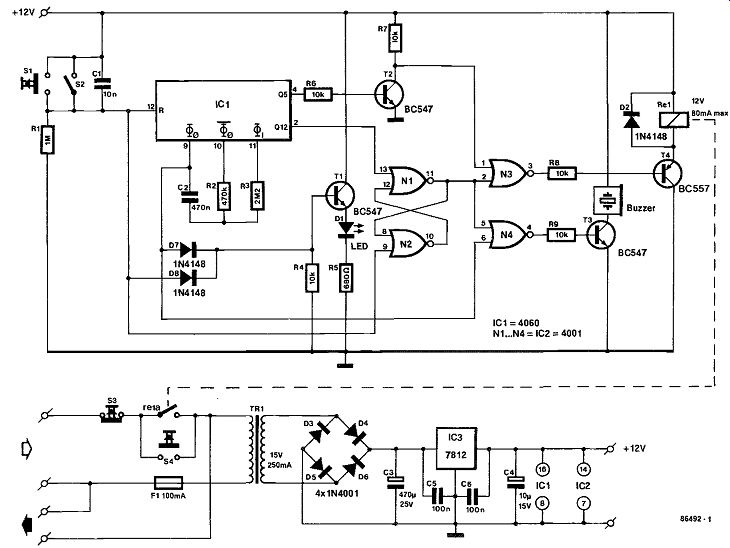
-----------
236 WATER-DIVINER
This little unit may be used to give an audible alarm when, for instance, a washing machine hose has burst, or when it starts to rain so you can get the washing in, or it can call you to the bathroom to turn the bathwater off. No doubt you will be able to think of some more uses.
The circuit may be powered from a 9 V battery which, since the current consumption is very low, will last for at least a year. After a year it should be replaced because it will then become unreliable owing to its self-discharge.
Basically, the unit consists of a sensor, an R-S bistable, an oscillator, and a driver stage for the alarm buzzer.
The sensor consists of a waste piece of wiring board, about 40 x 20 mm. Connect all odd and all even tracks together with wire links, that is, 1 to 3 to 5, and 2 to 4 to 6. Tin the tracks to protect them against corrosion. When the board is dry, the resistance between the two sets of tracks is high, but when it is wet, the resistance drops sharply.
The sensor is in series with resistor R2 and the two together, therefore, form a humidity-dependent voltage divider, which resets the R-S bistable when input 1 of N2 goes low. Oscillator N3 is then switched on, and driver N4 energizes the buzzer.
The bistable is set automatically on power up via the series combination R, and The circuit can also be used as a lie-detector. The sensor is then replaced by two lengths of wire of which the ends have been stripped. The bare wires are then placed in the hands of the person being interrogated. If the lies (which causes his hands to be come damp) the buzzer will sound.
The sensitivity of the circuit is determined by the value of R2: some experimenting may be necessary here.
The oscillator (and, therefore, the buzzer) is disabled by closing switch S1.
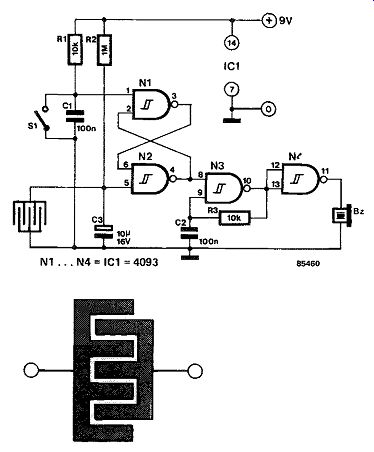
---------